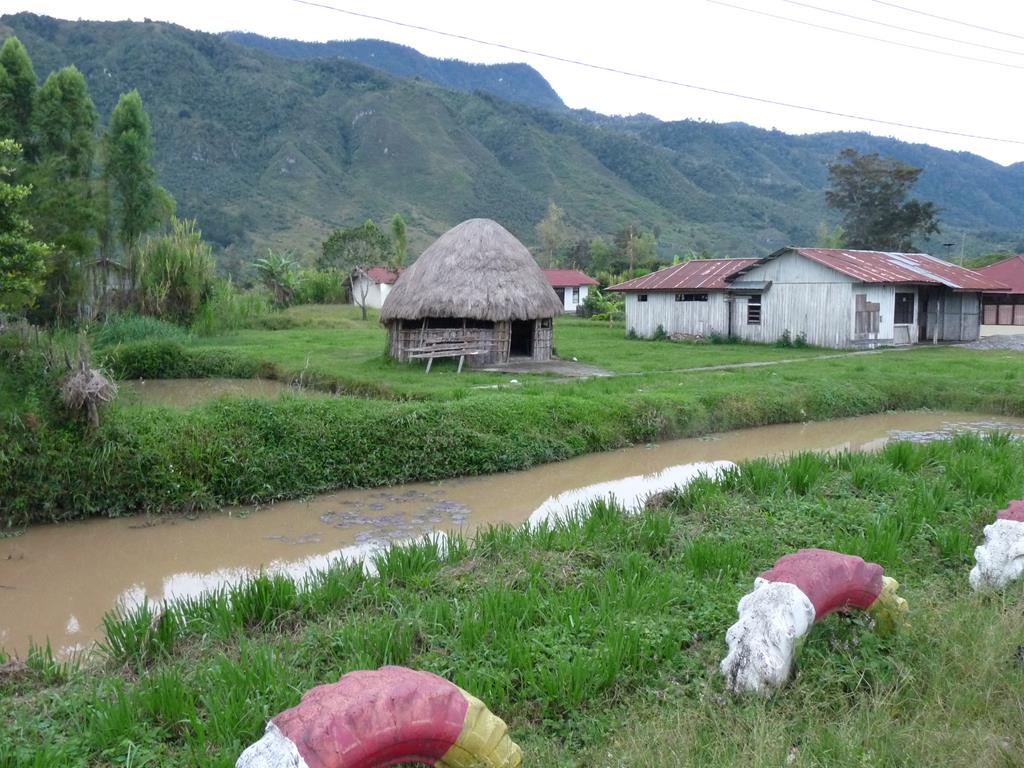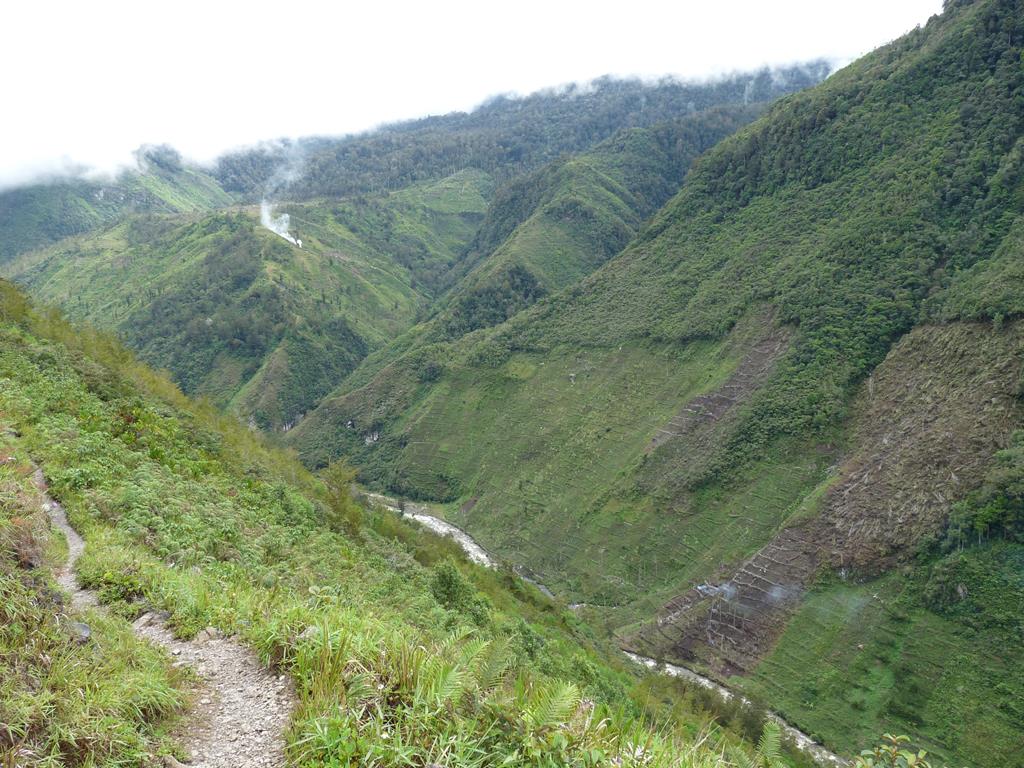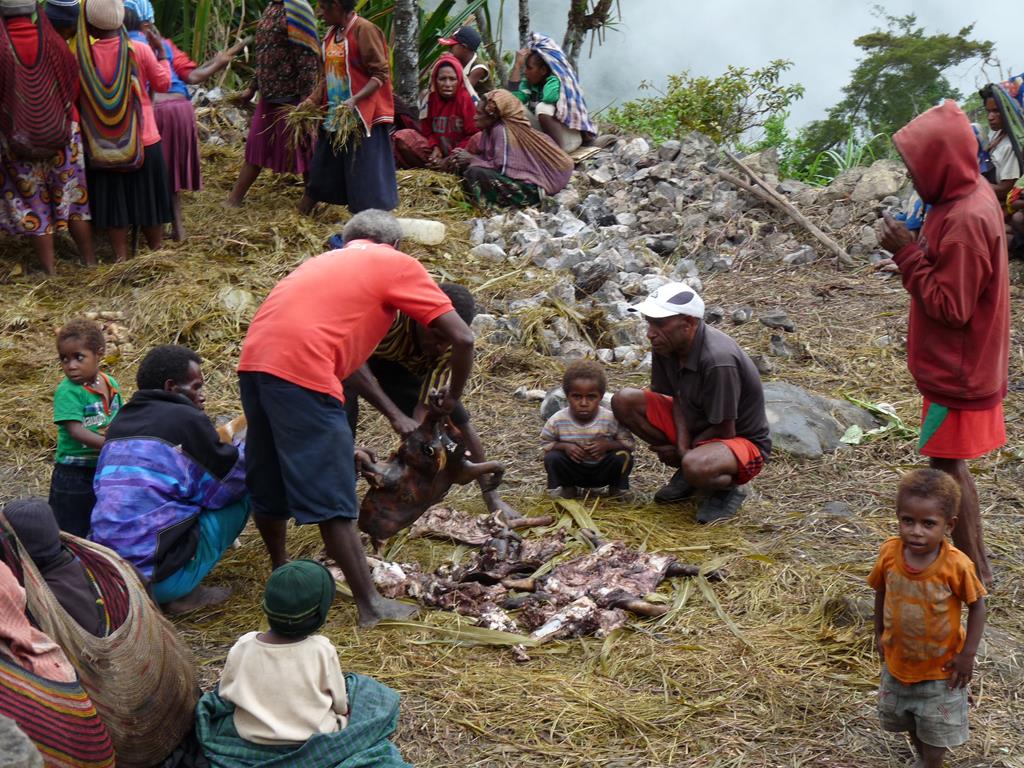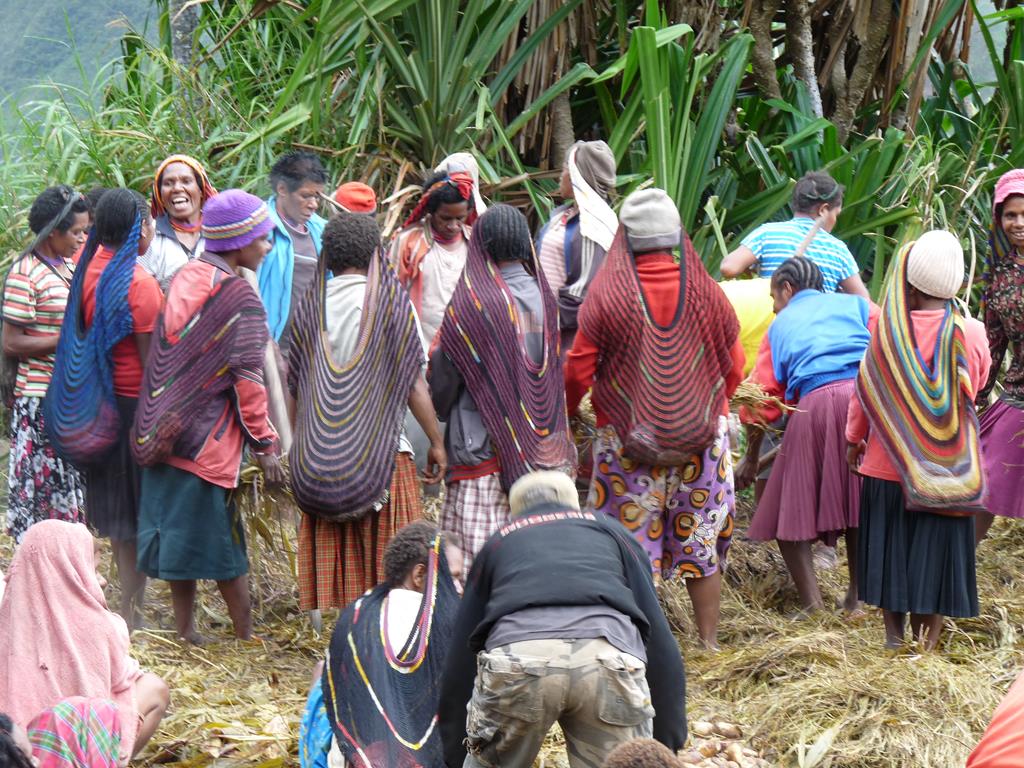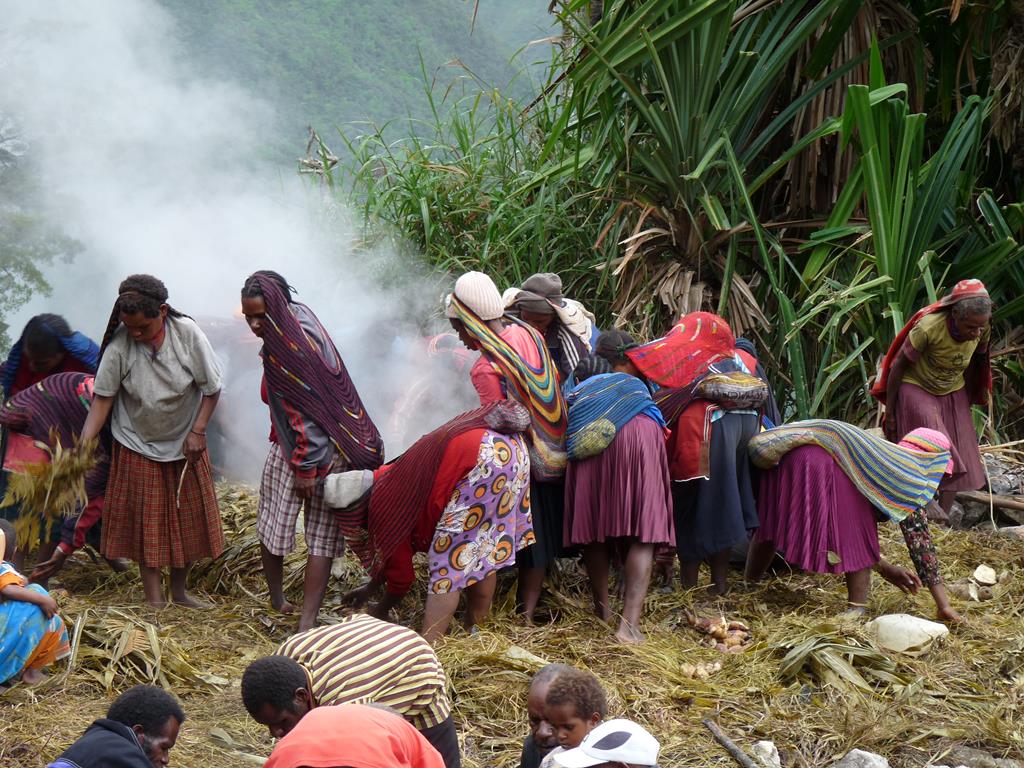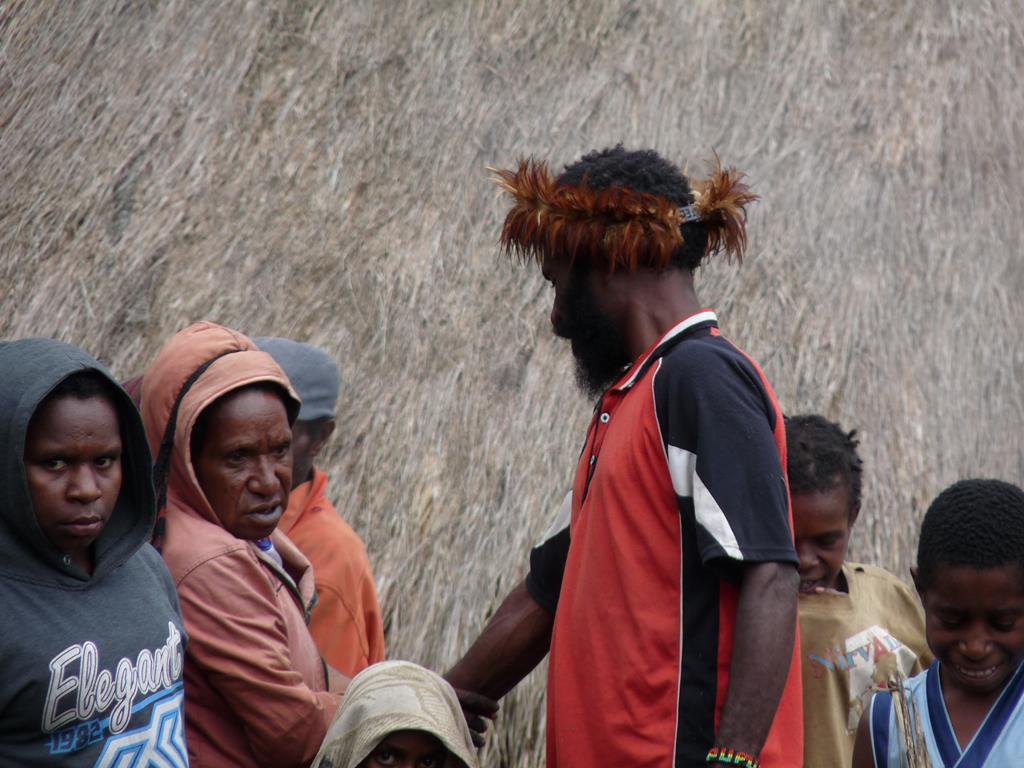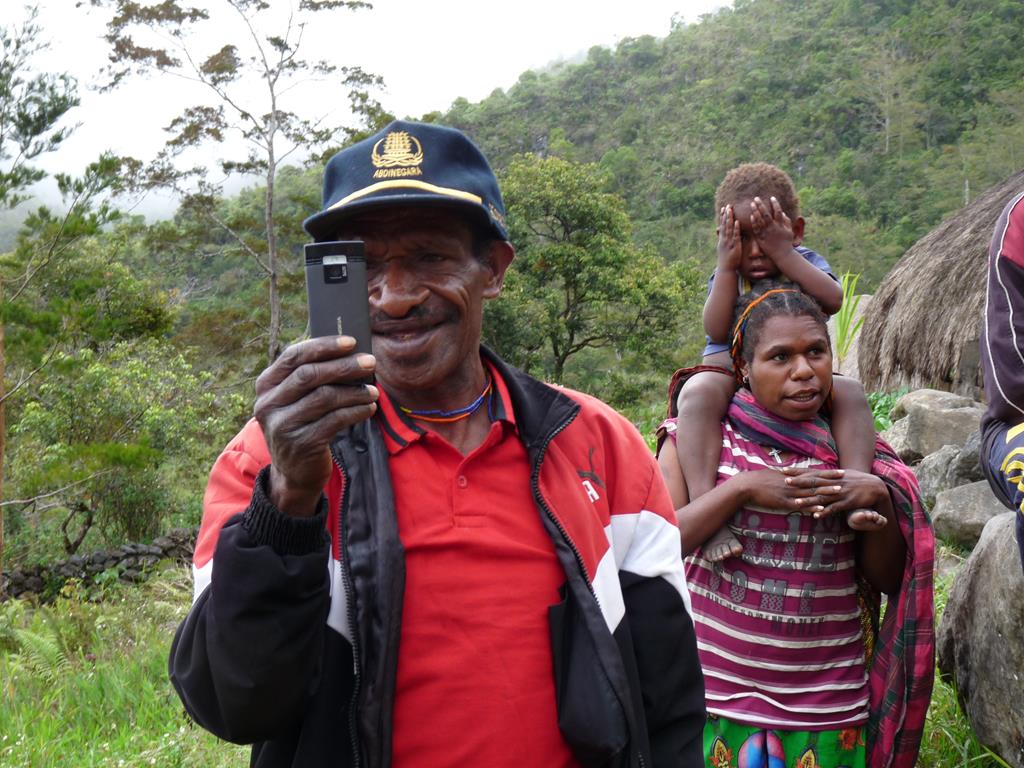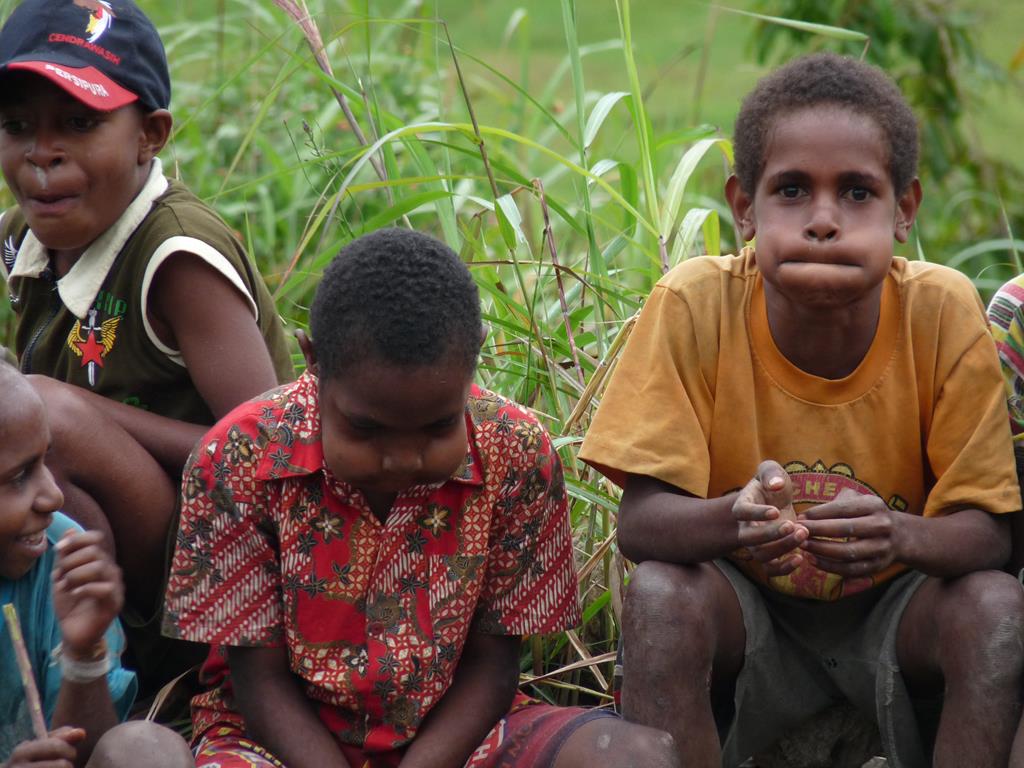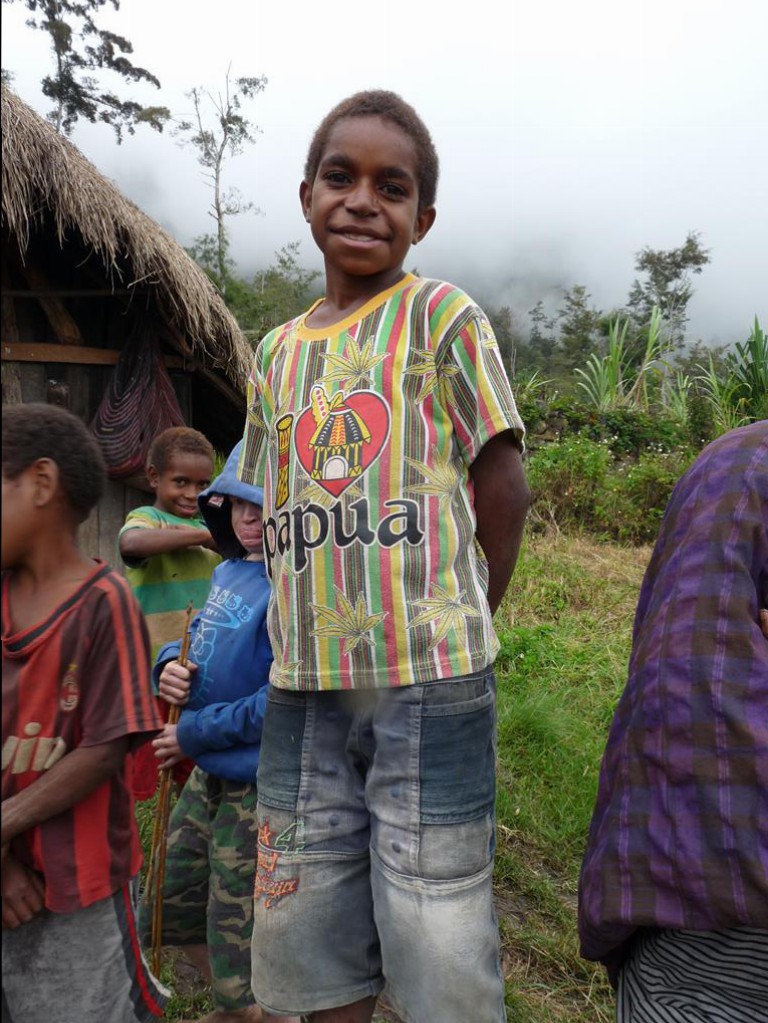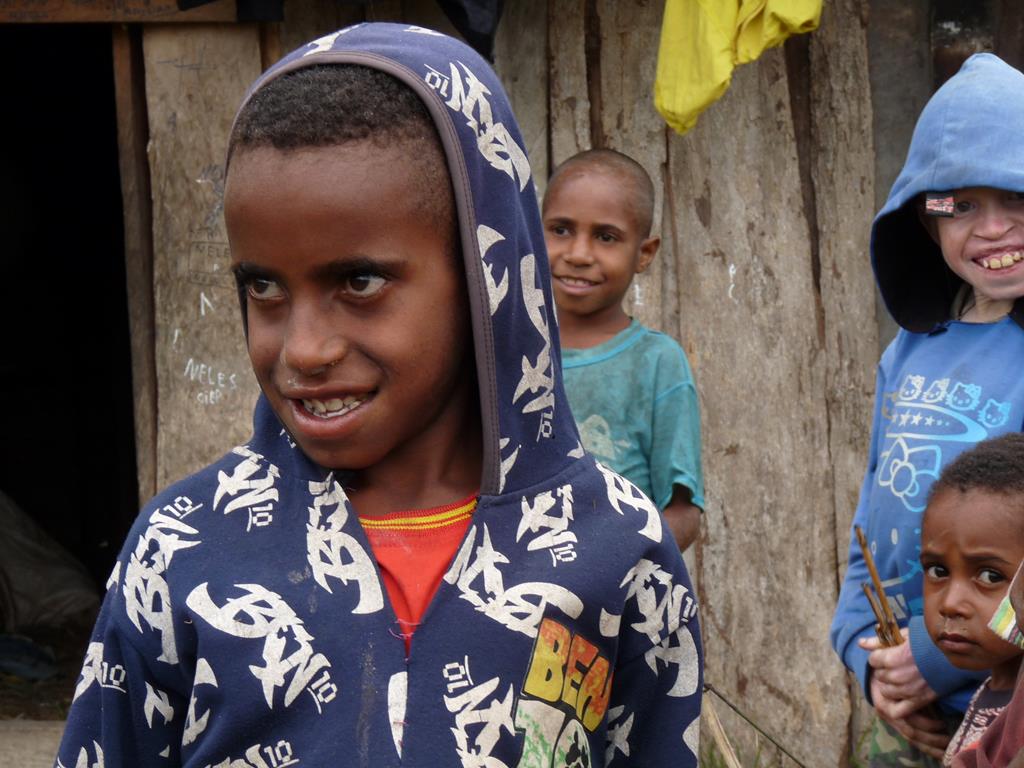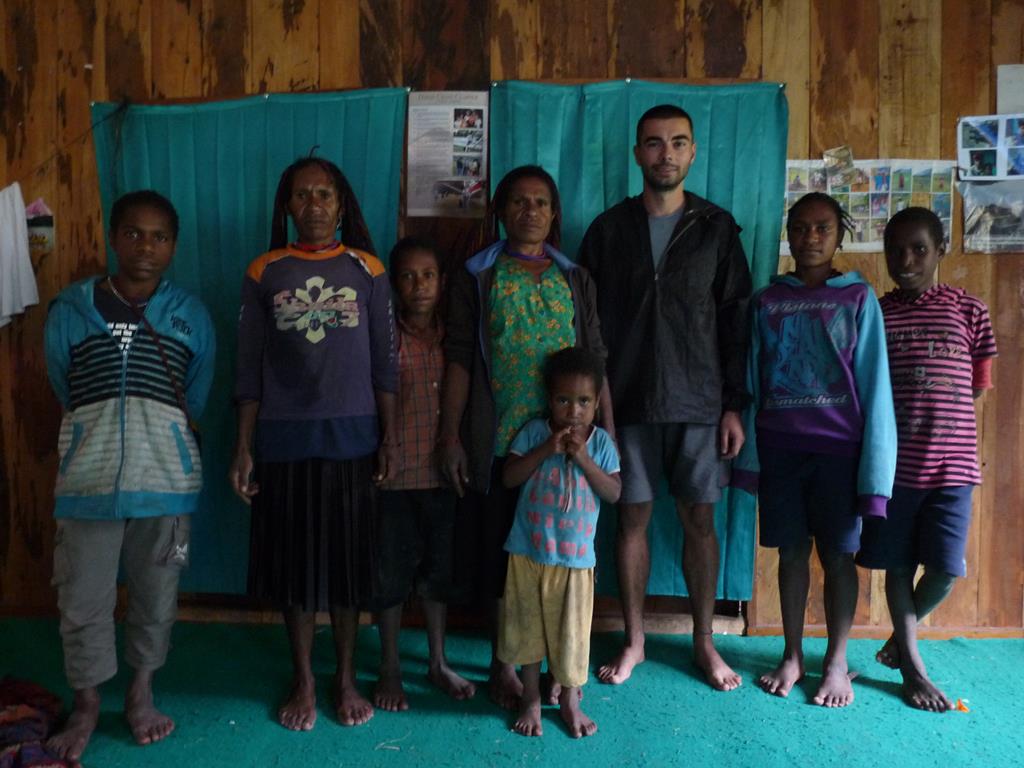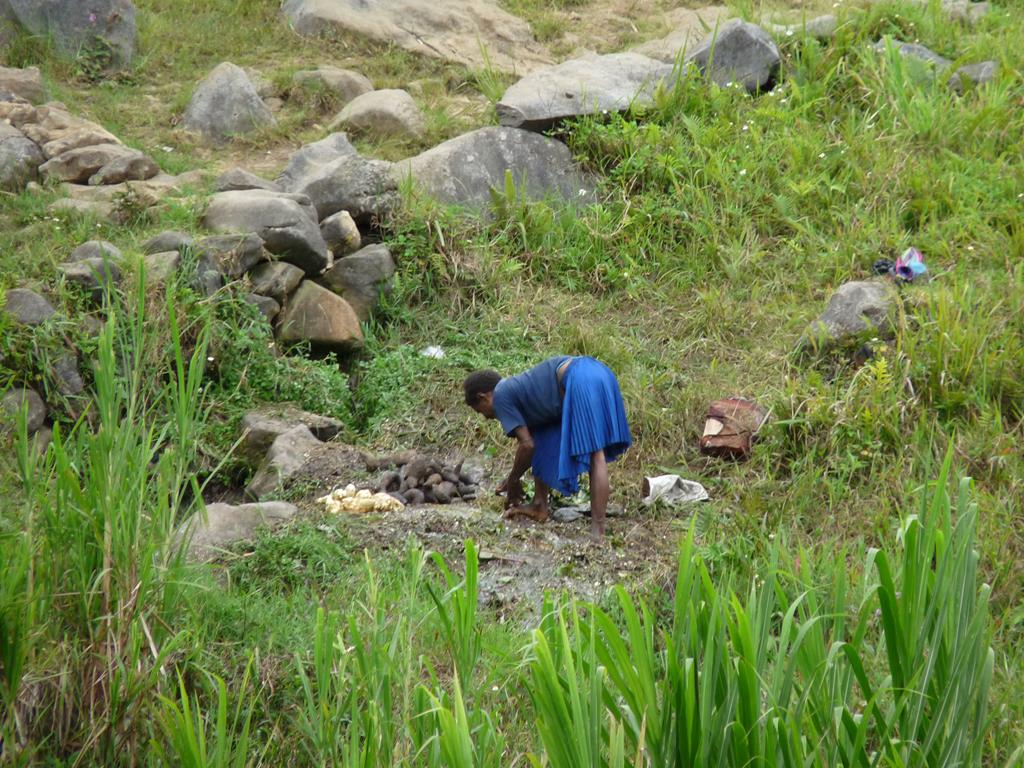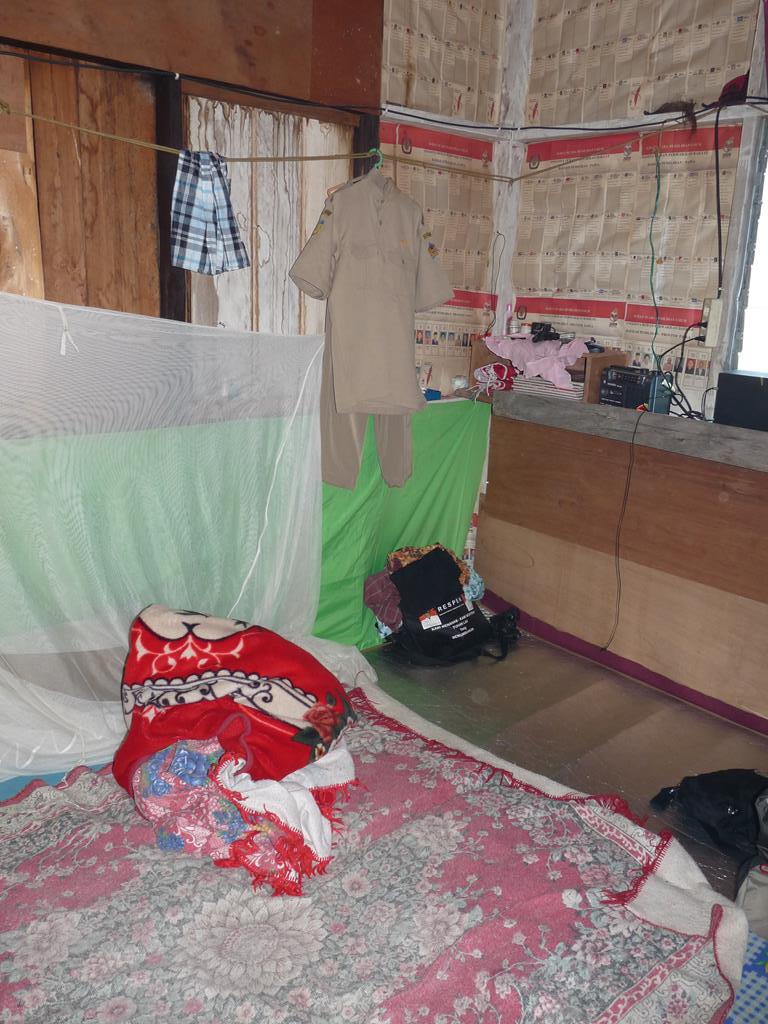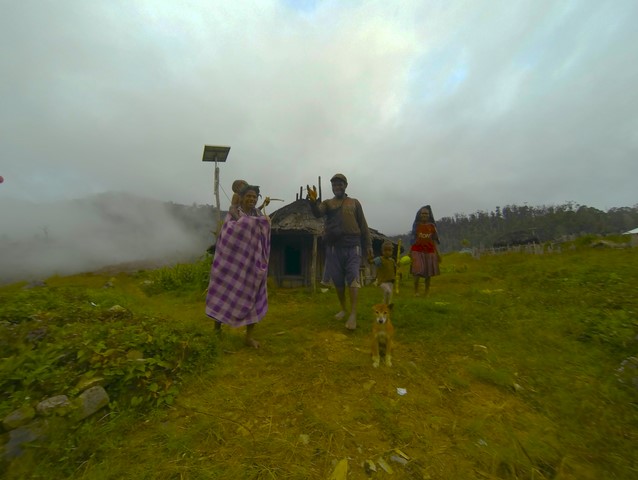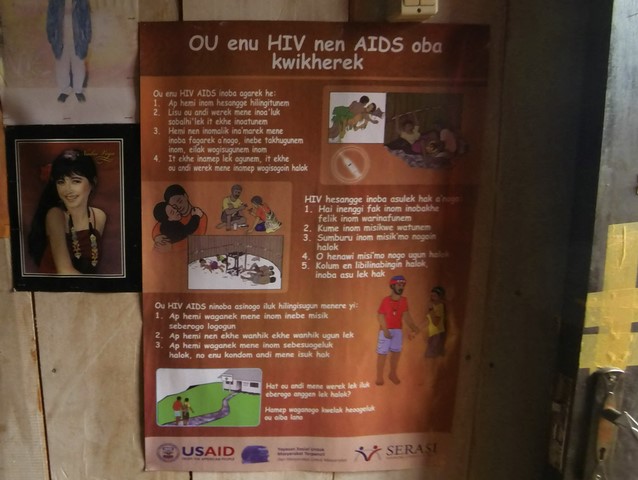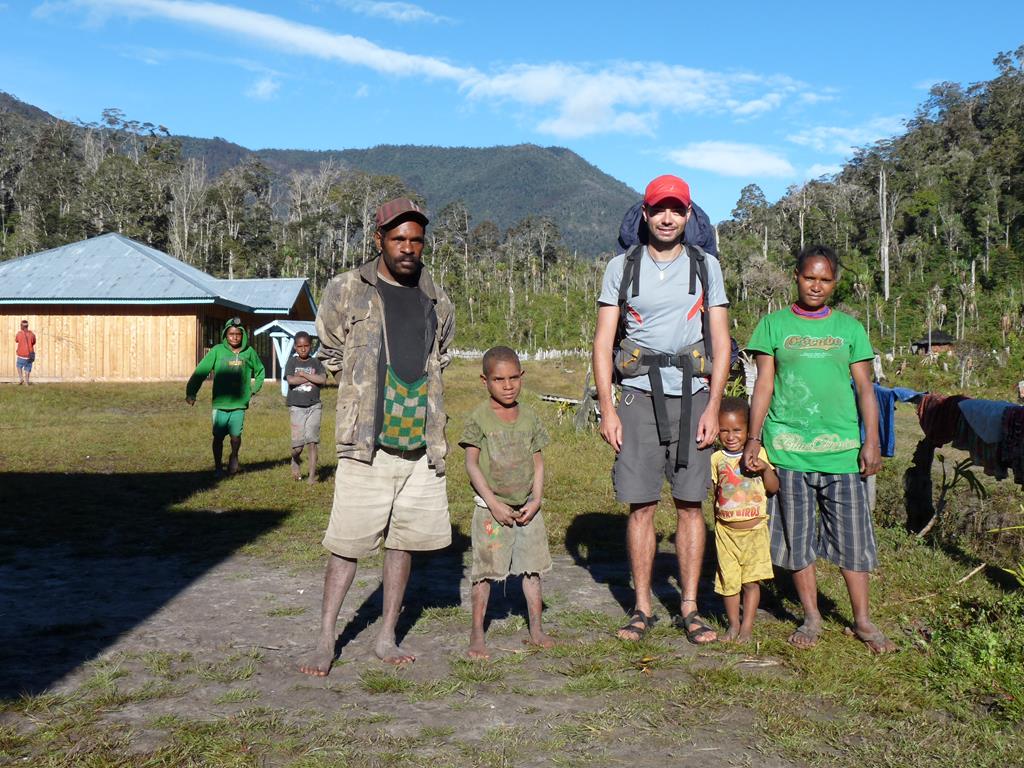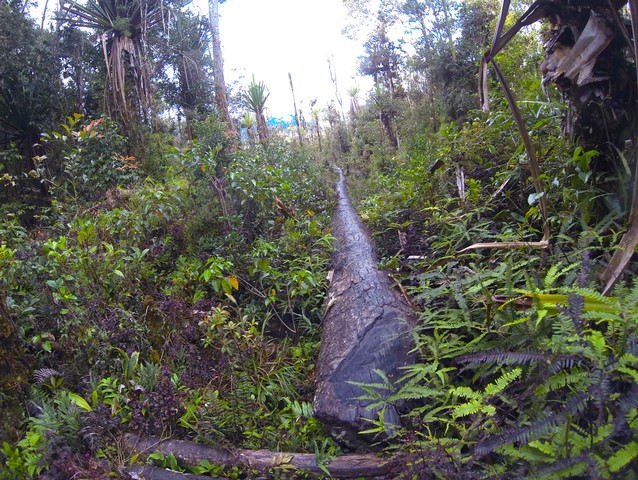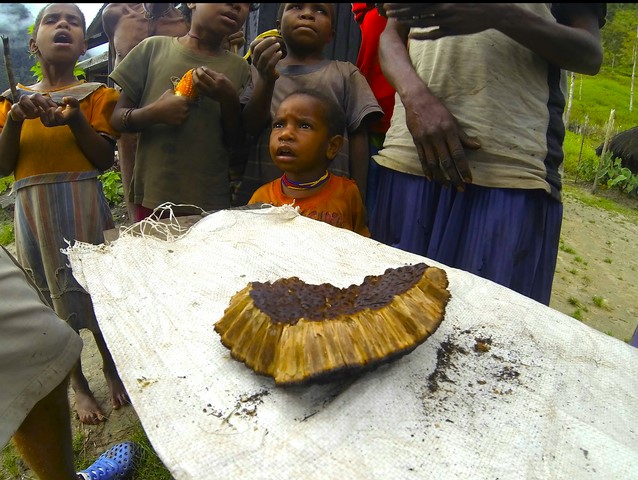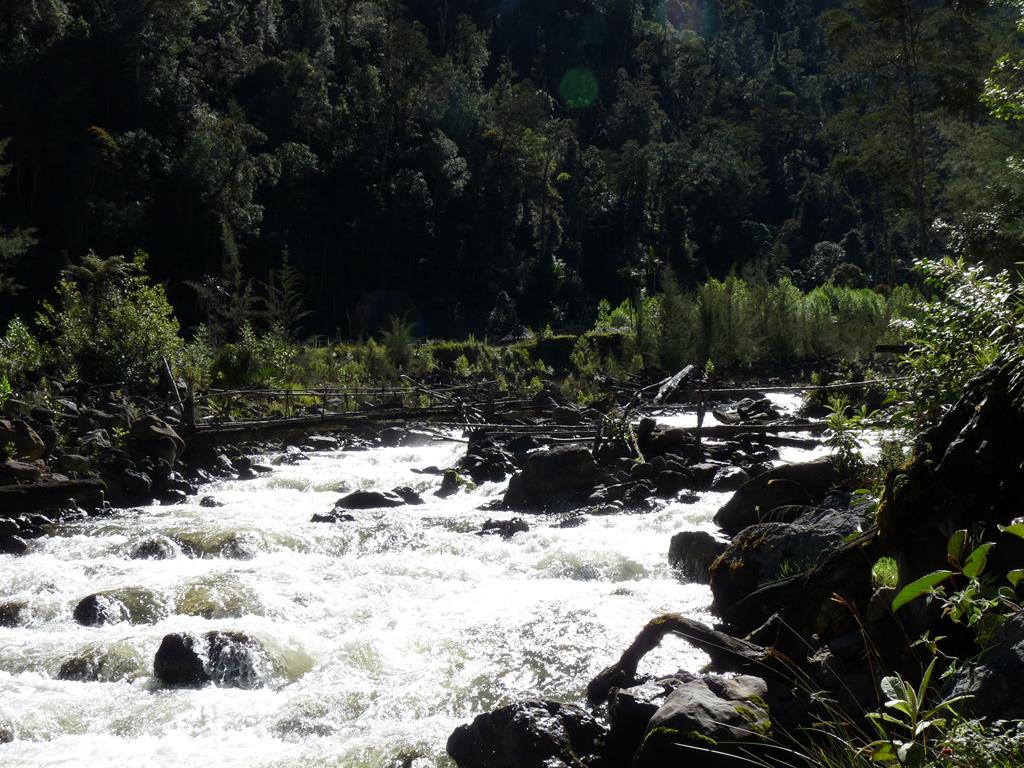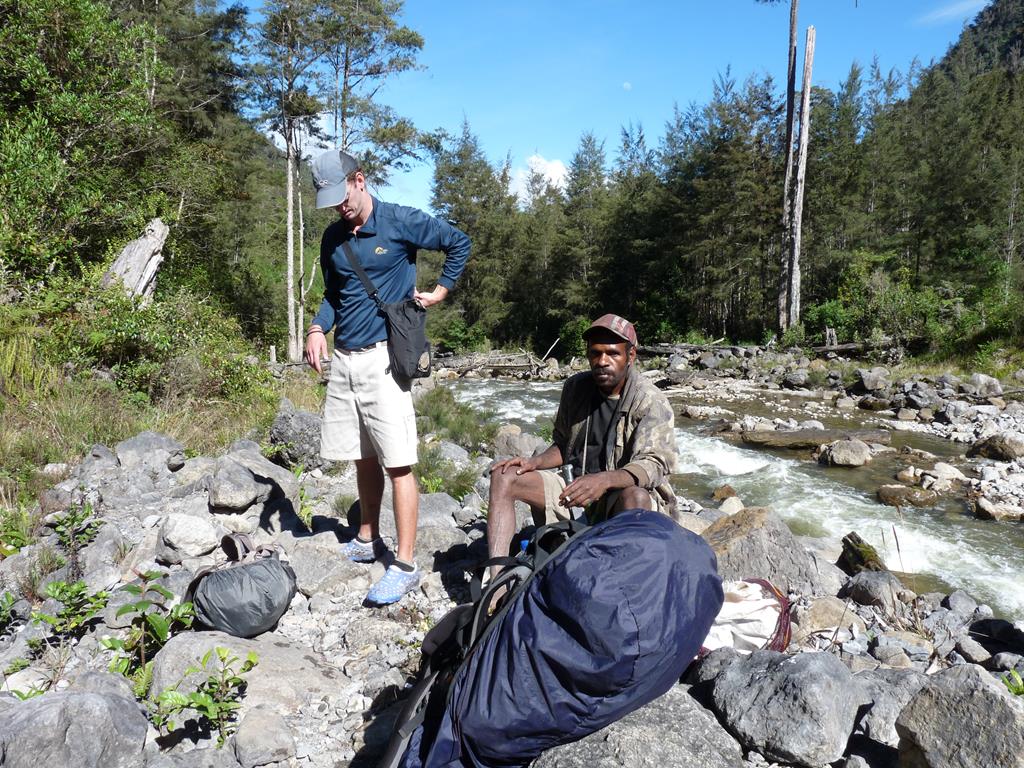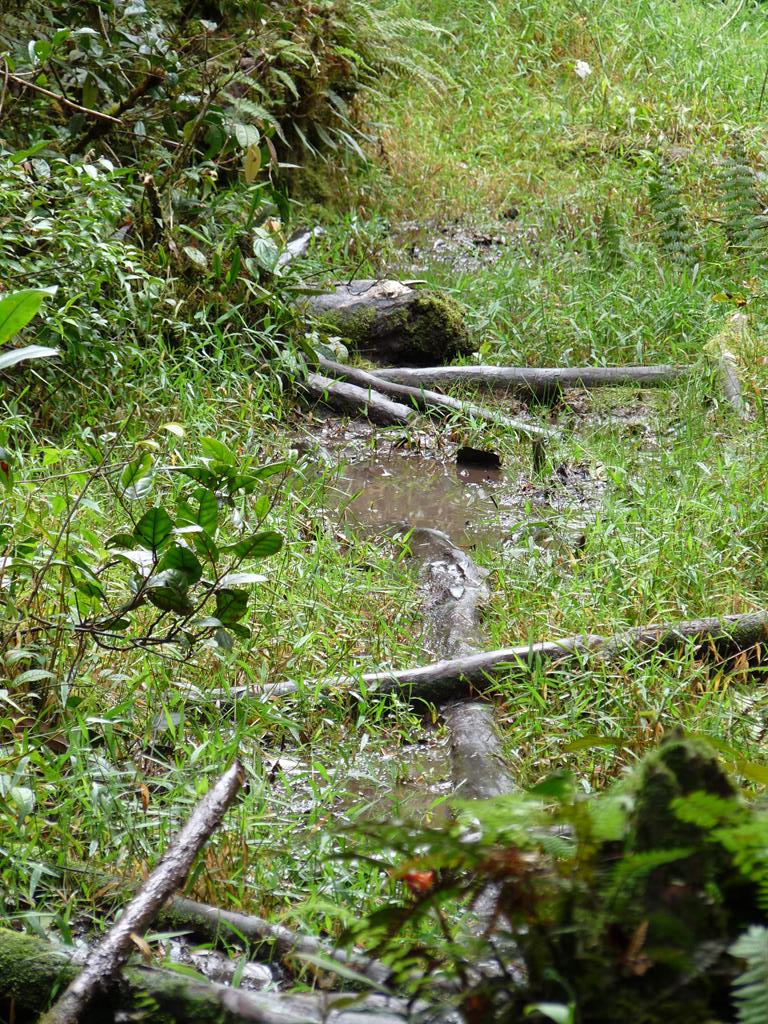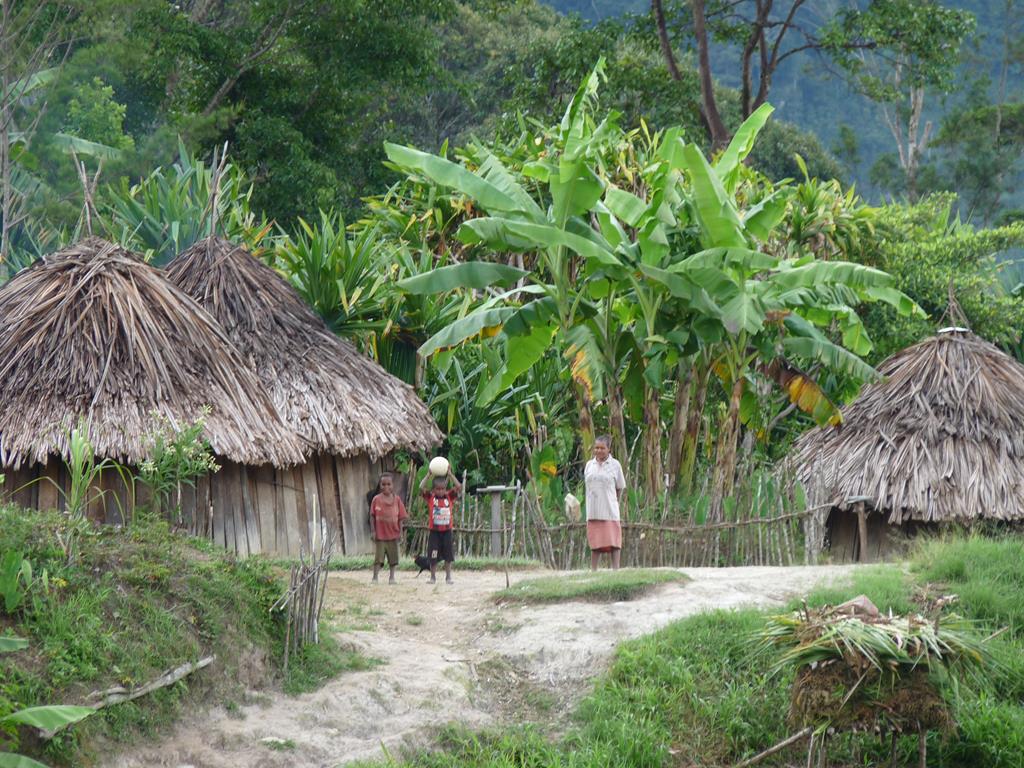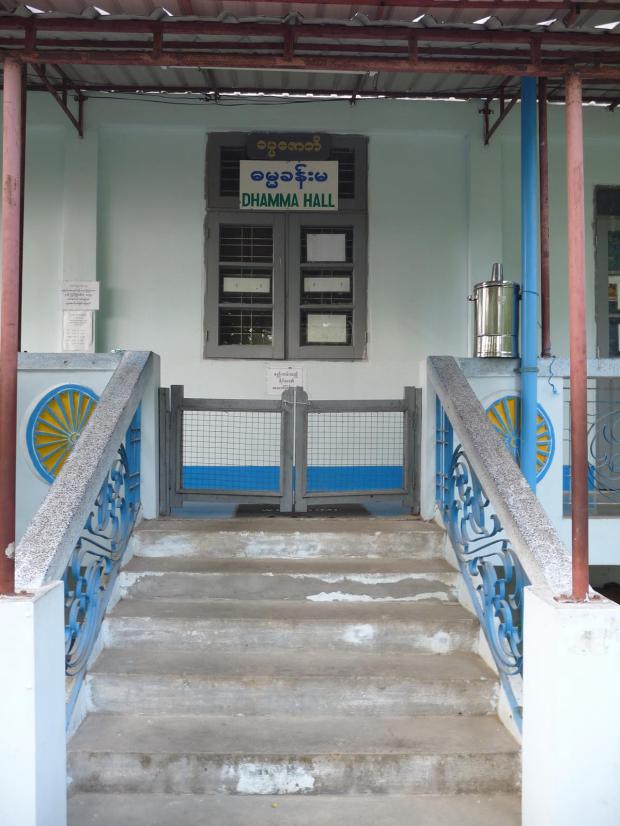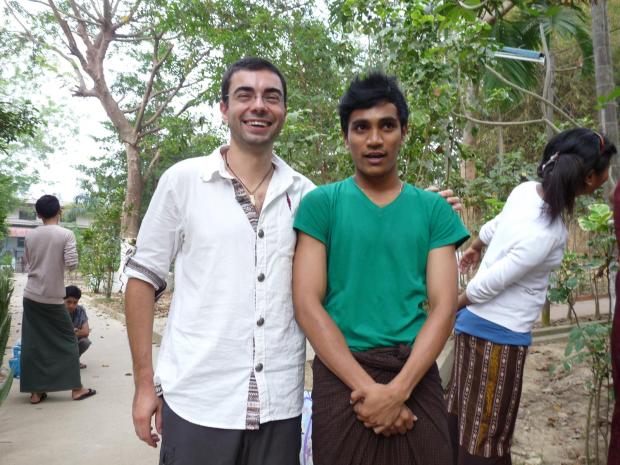“What time is it now?”
“There’s no time here!”
After over a month in Bali of working, driving a scooter and basically doing nothing, it was time for being a bit active again. Actually it was time for the real deal – I have been dreaming about visiting Melanesia for a long time. I am particularly interested in its linguistic and cultural diversity.
Through couchsurfing I met a Canadian, Nicholas, who wanted to go to the Baliem Valley at the same time as me. We met in Jayapura, the biggest city in Papua and took it from there.
The island of New Guinea is the second largest in the world and has over 1000 of the 7000 languages in the world. The area was unexplored until relatively recently and especially some of the people living in the middle of the island, isolated by high mountains, did not have contact with the outside world until as late as the 1960s. The valley of the river Baliem was discovered first when someone flew over it in the 1930s and a large amount of people were found there, using tools made of stone and bone and wearing very few clothes, despite the relatively chilly conditions.
The garment of choice for men was the koteka – a penis gourd (dried long pumpkin-like fruit) that keeps the penis upright with the help of a string around the waist. Women were topless and wearing grass skirts. On this trip I did not see any women or children in traditional outfits, but many older men, even in the center of the big town of Wamena were still walking around practically naked.
There are plenty of opportunities for trekking in the wide Baliem valley itself. We wanted to go to a neighbouring, less visited valley where different tribes lived. In the Baliem valley the people call themselves Dani or Lani. We wanted to go to where the Yali people lived – Yalimo. This would however involve going over some high mountains.
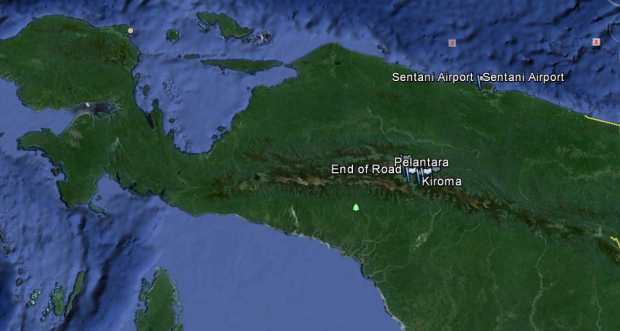
The Baliem Valley in Papua. It also took me a while to figure it out but here is the deal. The whole island is called New Guinea (second largest in the world after Greenland). It is shared by Papua New Guinea, the independent country to the east and Indonesia that rules over the western part of it. After the occupation Indonesia named it Irian Jaya, but that didn’t go down really well. It is better known as Western Papua (as opposed to PNG – eastern Papua). However, to make things a bit more complicated, Indonesia actually has devided its part of the island into two provinces – Papua (the bigger part of it to the east) and West Papua (the “bird’s head” to the west). So the Baliem Valley is in the Papua province of Indonesia. Sentani airport is the airport of Jayapura.
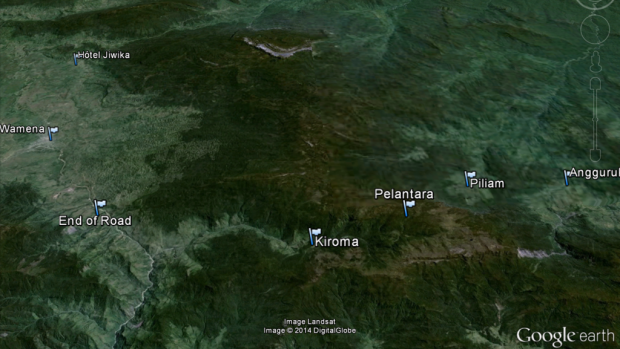
This is our route in the highlands. First we went north of Wamena to the village of Jiwika. Then back to Wamena and to the end of the road in the south to the village of Kurima. From Kurima we trekked for two days in a beautiful valley to Kiroma, from where we had a hard, wet, dirty and exhausting trek over two mountain passes to reach Angguruk. It took us five days to reach Angguruk from Kurima.
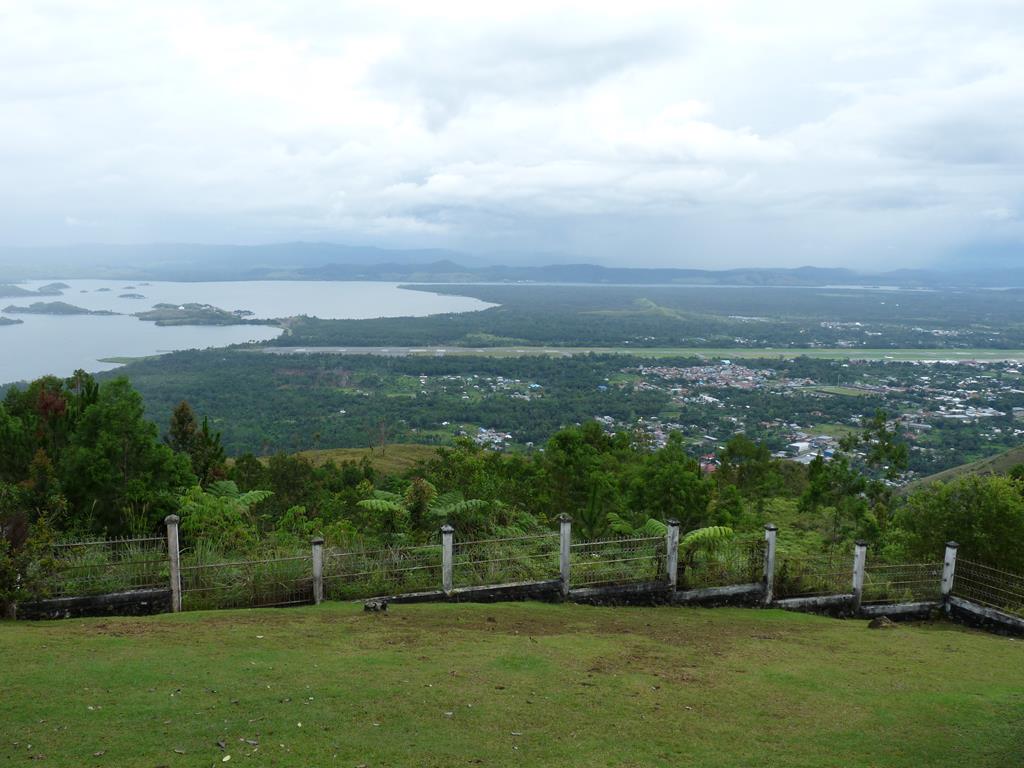 Sentani is a town a bit outside of Jayapura where the airport is. The hill next to it is a memorial to some general from World War II
Sentani is a town a bit outside of Jayapura where the airport is. The hill next to it is a memorial to some general from World War II Sentani is a town a bit outside of Jayapura where the airport is. The hill next to it is a memorial to some general from World War II
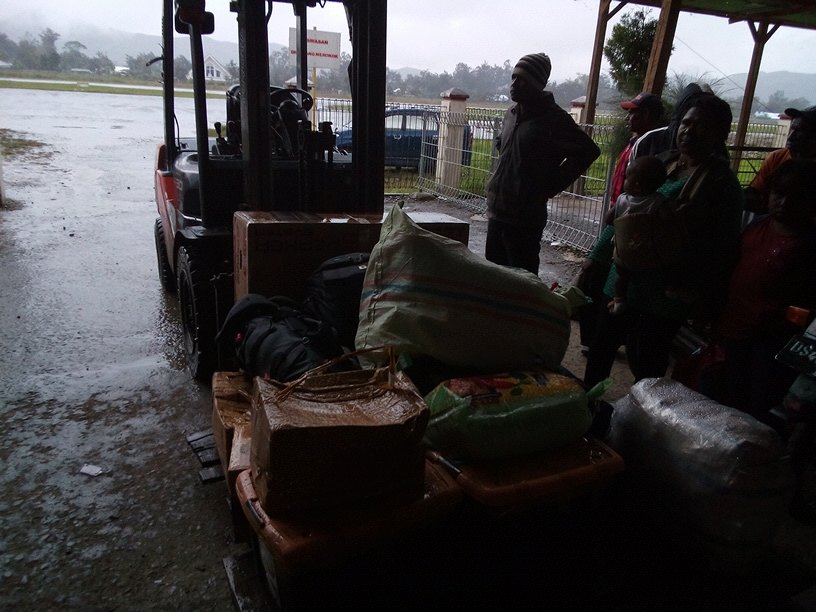 Getting to Wamena is straightforward. In the sense that there are not many options. Triana air flies up to five times daily from Jayapura to Wamena on Boeings with a lot of space in the back for pigs and such. On some maps there is a road to Wamena but that doesn’t seem to actually exist. The terminal building at Wamena airport consists of a roof and baggage is delivered directly on forklifts. Wamena is the biggest town in the Papuan Highlands. Migrant workers from the rest of Indonesia, including women covered head to toe, coexist with local Papuans, sometimes wearing nothing but their modest koteka.
Getting to Wamena is straightforward. In the sense that there are not many options. Triana air flies up to five times daily from Jayapura to Wamena on Boeings with a lot of space in the back for pigs and such. On some maps there is a road to Wamena but that doesn’t seem to actually exist. The terminal building at Wamena airport consists of a roof and baggage is delivered directly on forklifts. Wamena is the biggest town in the Papuan Highlands. Migrant workers from the rest of Indonesia, including women covered head to toe, coexist with local Papuans, sometimes wearing nothing but their modest koteka.Getting to Wamena is straightforward. In the sense that there are not many options. Triana air flies up to five times daily from Jayapura to Wamena on Boeings with a lot of space in the back for pigs and such. On some maps there is a road to Wamena but that doesn't seem to actually exist. The terminal building at Wamena airport consists of a roof and baggage is delivered directly on forklifts. Wamena is the biggest town in the Papuan Highlands. Migrant workers from the rest of Indonesia, including women covered head to toe, coexist with local Papuans, sometimes wearing nothing but their modest koteka.
 We arrived in Wamena on Sunday morning and everything was closed until 1 pm so we killed some time at the church, then had lunch at a hotel and then left for a small village called Jiwika, 1 hour to the north of Wamena by public transportation. There’s a traditional village close to Jiwika with traditional houses and a 200 year old mummy that can be brought out of its hut. That was recommended somewhere on the Internet. Well, once we got there we were asked for whopping amounts to see the mummy and then some more to take pictures. By the time the price went down to acceptable levels the whole thing looked more like a circus so we walked away. If you want to see the mummy, there must be pictures on the Internet. After staying the night at a small guesthouse nearby, we went for a hike in this valley , up to a salt water spring.
We arrived in Wamena on Sunday morning and everything was closed until 1 pm so we killed some time at the church, then had lunch at a hotel and then left for a small village called Jiwika, 1 hour to the north of Wamena by public transportation. There’s a traditional village close to Jiwika with traditional houses and a 200 year old mummy that can be brought out of its hut. That was recommended somewhere on the Internet. Well, once we got there we were asked for whopping amounts to see the mummy and then some more to take pictures. By the time the price went down to acceptable levels the whole thing looked more like a circus so we walked away. If you want to see the mummy, there must be pictures on the Internet. After staying the night at a small guesthouse nearby, we went for a hike in this valley , up to a salt water spring. We arrived in Wamena on Sunday morning and everything was closed until 1 pm so we killed some time at the church, then had lunch at a hotel and then left for a small village called Jiwika, 1 hour to the north of Wamena by public transportation. There's a traditional village close to Jiwika with traditional houses and a 200 year old mummy that can be brought out of its hut. That was recommended somewhere on the Internet. Well, once we got there we were asked for whopping amounts to see the mummy and then some more to take pictures. By the time the price went down to acceptable levels the whole thing looked more like a circus so we walked away. If you want to see the mummy, there must be pictures on the Internet. After staying the night at a small guesthouse nearby, we went for a hike in this valley , up to a salt water spring.
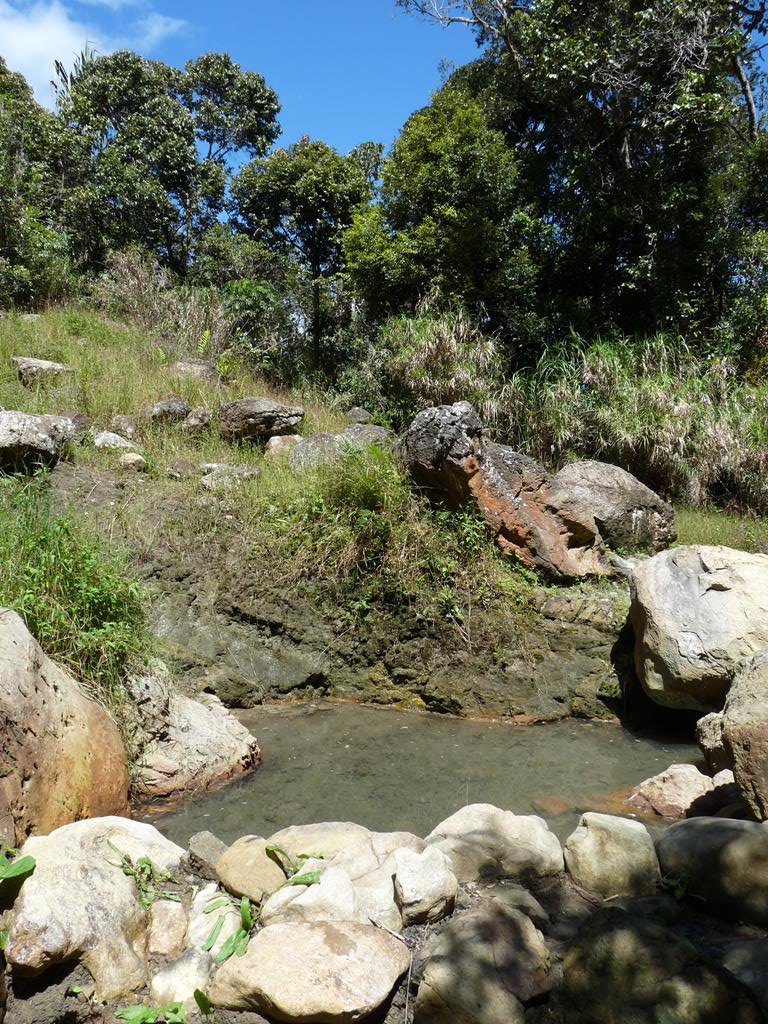 The salt water spring itself was nothing crazy – just a pool of water. I tasted it to make sure we are at the right place. It is quite salty. Local people extract the salt by soaking dried banana tree trunks in the salt water, then letting them dry and burning them. The salty ashes are then used as salt.
The salt water spring itself was nothing crazy – just a pool of water. I tasted it to make sure we are at the right place. It is quite salty. Local people extract the salt by soaking dried banana tree trunks in the salt water, then letting them dry and burning them. The salty ashes are then used as salt. The salt water spring itself was nothing crazy - just a pool of water. I tasted it to make sure we are at the right place. It is quite salty. Local people extract the salt by soaking dried banana tree trunks in the salt water, then letting them dry and burning them. The salty ashes are then used as salt.
 After spending the morning trekking in Jiwika, we took a “bus” back to Wamena. The “bus” broke down a bit before the town so we had to walk for a while. Then we visited an Internet shop called Papua.com that we knew sold a map of the area where we wanted to go trekking. The Japanese man there was a lot less helpful than the Lonely Planet described him but we got the map and managed to get the last bus to Kurima (easy name to remember for Bulgarian ears). It was already dark when the bus stopped in the middle of nowhere. The road had been washed away by a river and we had to walk the last couple of kilometers to the village. We had some locals to show us the way across the knee deep river and then on to the village. They kept asking where we would sleep and we kept saying we had no idea. We ended up on the floor of a church and had a nice one hour lesson of the local language. The shower and toilet were down in the river. There’s a police station in Kurima where we had to register our travel permits and then it was only walking from here on.
After spending the morning trekking in Jiwika, we took a “bus” back to Wamena. The “bus” broke down a bit before the town so we had to walk for a while. Then we visited an Internet shop called Papua.com that we knew sold a map of the area where we wanted to go trekking. The Japanese man there was a lot less helpful than the Lonely Planet described him but we got the map and managed to get the last bus to Kurima (easy name to remember for Bulgarian ears). It was already dark when the bus stopped in the middle of nowhere. The road had been washed away by a river and we had to walk the last couple of kilometers to the village. We had some locals to show us the way across the knee deep river and then on to the village. They kept asking where we would sleep and we kept saying we had no idea. We ended up on the floor of a church and had a nice one hour lesson of the local language. The shower and toilet were down in the river. There’s a police station in Kurima where we had to register our travel permits and then it was only walking from here on. After spending the morning trekking in Jiwika, we took a
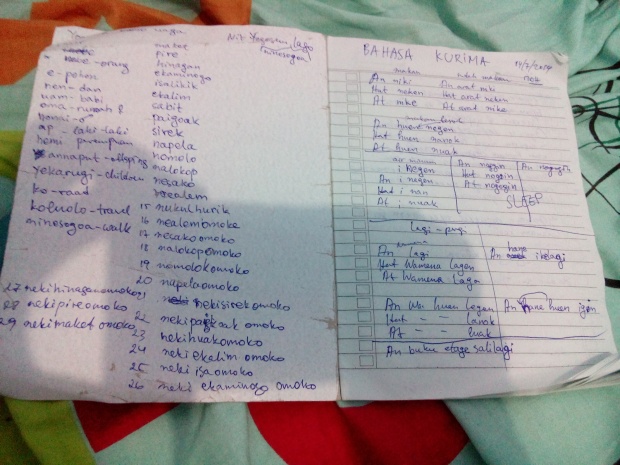
In the language of Kurima the counting system is of base 29. The words for numbers are body parts. You start counting with the fingers of the right hand and up the arm to the top of the head (15) and down the other arm and hand until 29.
 Just when we arrived at the village of Hitugi it started raining. We wanted to continue to the next village and stay there that night but as we were waiting for the rain to stop we were invited to a pig feast up the hill. Someone had died a couple of days earlier and the person is commemorated with three days of eating pig. In Papua pig is cooked by making some big stones really hot, then putting them in a pit in the ground, then the pigs and some sweet potatoes. The whole thing is covered with earth and left like that for many hours. We joined just as the food was being taken out, which involves a lot of hot stones being thrown around and a lot of impatient looks. Pigs are very important for most highlanders. They are the main source of protein and can also pay debts, buy wives etc. I overheard that the going rate is four pigs for a wife. And you can buy more than one.
Just when we arrived at the village of Hitugi it started raining. We wanted to continue to the next village and stay there that night but as we were waiting for the rain to stop we were invited to a pig feast up the hill. Someone had died a couple of days earlier and the person is commemorated with three days of eating pig. In Papua pig is cooked by making some big stones really hot, then putting them in a pit in the ground, then the pigs and some sweet potatoes. The whole thing is covered with earth and left like that for many hours. We joined just as the food was being taken out, which involves a lot of hot stones being thrown around and a lot of impatient looks. Pigs are very important for most highlanders. They are the main source of protein and can also pay debts, buy wives etc. I overheard that the going rate is four pigs for a wife. And you can buy more than one. Just when we arrived at the village of Hitugi it started raining. We wanted to continue to the next village and stay there that night but as we were waiting for the rain to stop we were invited to a pig feast up the hill. Someone had died a couple of days earlier and the person is commemorated with three days of eating pig. In Papua pig is cooked by making some big stones really hot, then putting them in a pit in the ground, then the pigs and some sweet potatoes. The whole thing is covered with earth and left like that for many hours. We joined just as the food was being taken out, which involves a lot of hot stones being thrown around and a lot of impatient looks. Pigs are very important for most highlanders. They are the main source of protein and can also pay debts, buy wives etc. I overheard that the going rate is four pigs for a wife. And you can buy more than one.
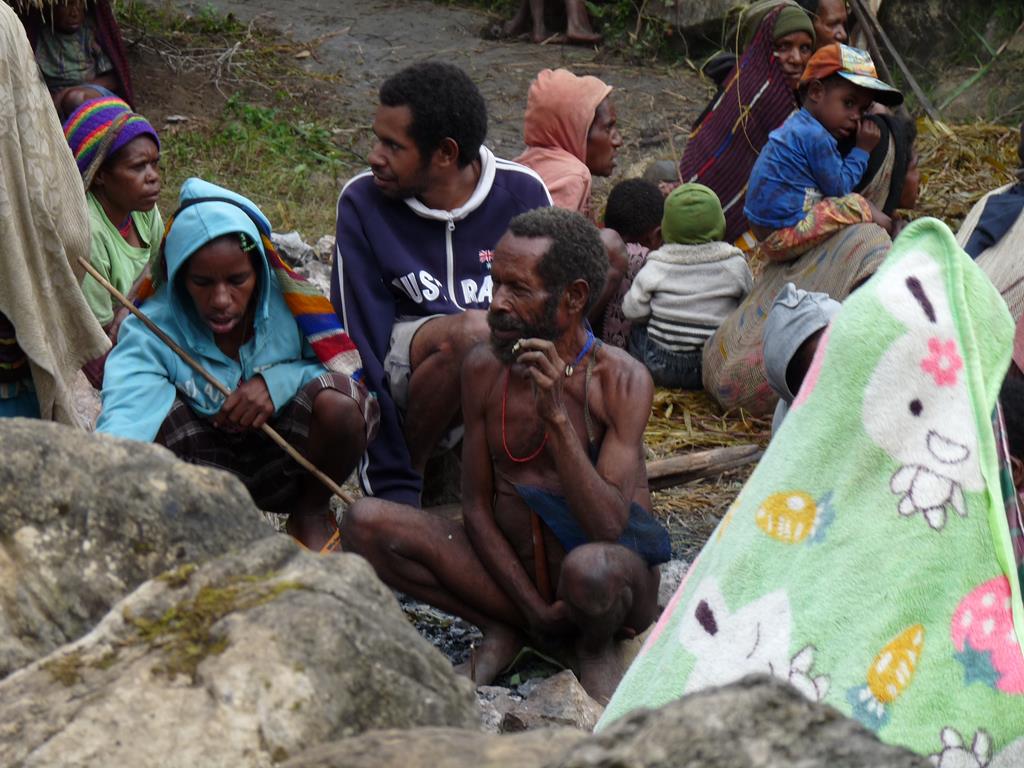 In Hitugi, as in most other villages, very few older men were wearing their traditional outfits
In Hitugi, as in most other villages, very few older men were wearing their traditional outfitsIn Hitugi, as in most other villages, very few older men were wearing their traditional outfits
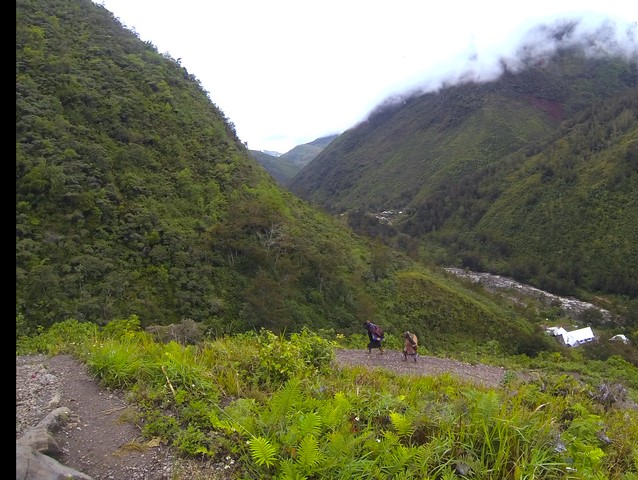 After the pig feast we stayed the night in Hitugi and the next day continued to Kiroma. That meant we had to go slightly down to the river, cross a bridge (here you can choose to go back to Wamena on the other side of the valley) and then ascended a whole lot to reach Kiroma. On the way we made a longer stop in Yogosem, which had an airstrip and we had lunch with a very friendly and very Christian lady.
After the pig feast we stayed the night in Hitugi and the next day continued to Kiroma. That meant we had to go slightly down to the river, cross a bridge (here you can choose to go back to Wamena on the other side of the valley) and then ascended a whole lot to reach Kiroma. On the way we made a longer stop in Yogosem, which had an airstrip and we had lunch with a very friendly and very Christian lady. After the pig feast we stayed the night in Hitugi and the next day continued to Kiroma. That meant we had to go slightly down to the river, cross a bridge (here you can choose to go back to Wamena on the other side of the valley) and then ascended a whole lot to reach Kiroma. On the way we made a longer stop in Yogosem, which had an airstrip and we had lunch with a very friendly and very Christian lady.
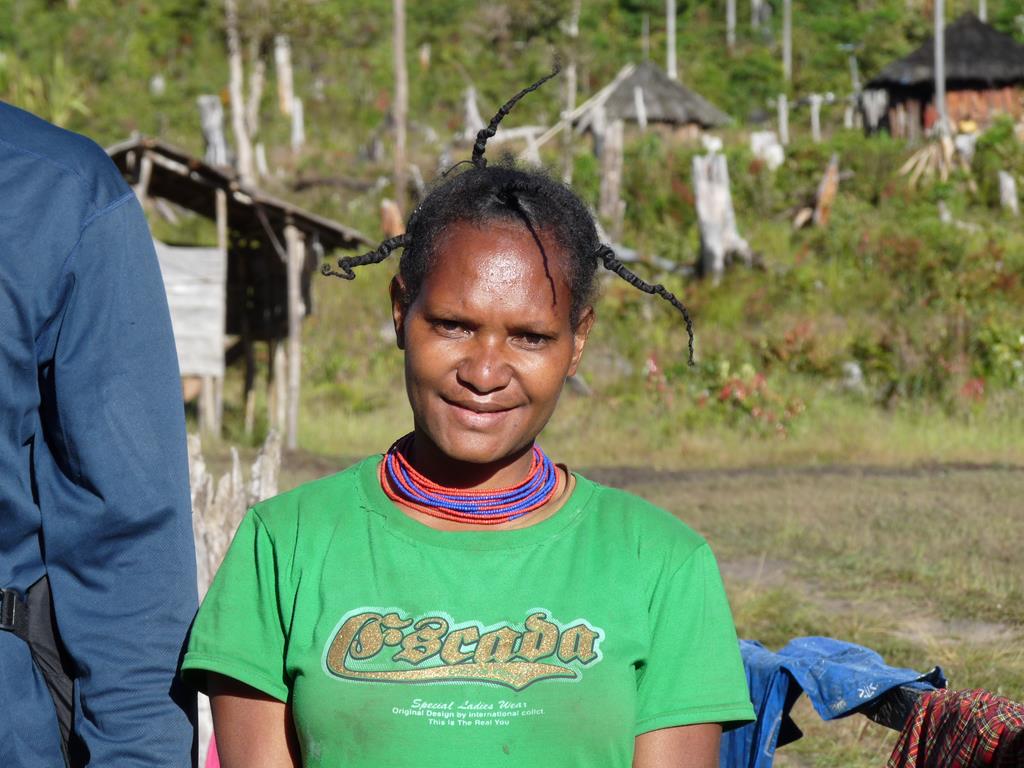 This lady hosted us in Kiroma. They had a special room for guests with mattresses. She cooked for us and helped us a lot. She and her very young daughter got infected with malaria after a visit to Jayapura. Kiroma itself is way above 2000 meters so there shouldn’t be many malaria mosquitoes. Her slightly older sons smoked already. And she holds the copyright to the quote in this blog post’s title. I’m more than ashamed to say that I forgot her name.
This lady hosted us in Kiroma. They had a special room for guests with mattresses. She cooked for us and helped us a lot. She and her very young daughter got infected with malaria after a visit to Jayapura. Kiroma itself is way above 2000 meters so there shouldn’t be many malaria mosquitoes. Her slightly older sons smoked already. And she holds the copyright to the quote in this blog post’s title. I’m more than ashamed to say that I forgot her name. This lady hosted us in Kiroma. They had a special room for guests with mattresses. She cooked for us and helped us a lot. She and her very young daughter got infected with malaria after a visit to Jayapura. Kiroma itself is way above 2000 meters so there shouldn't be many malaria mosquitoes. Her slightly older sons smoked already. And she holds the copyright to the quote in this blog post's title. I'm more than ashamed to say that I forgot her name.
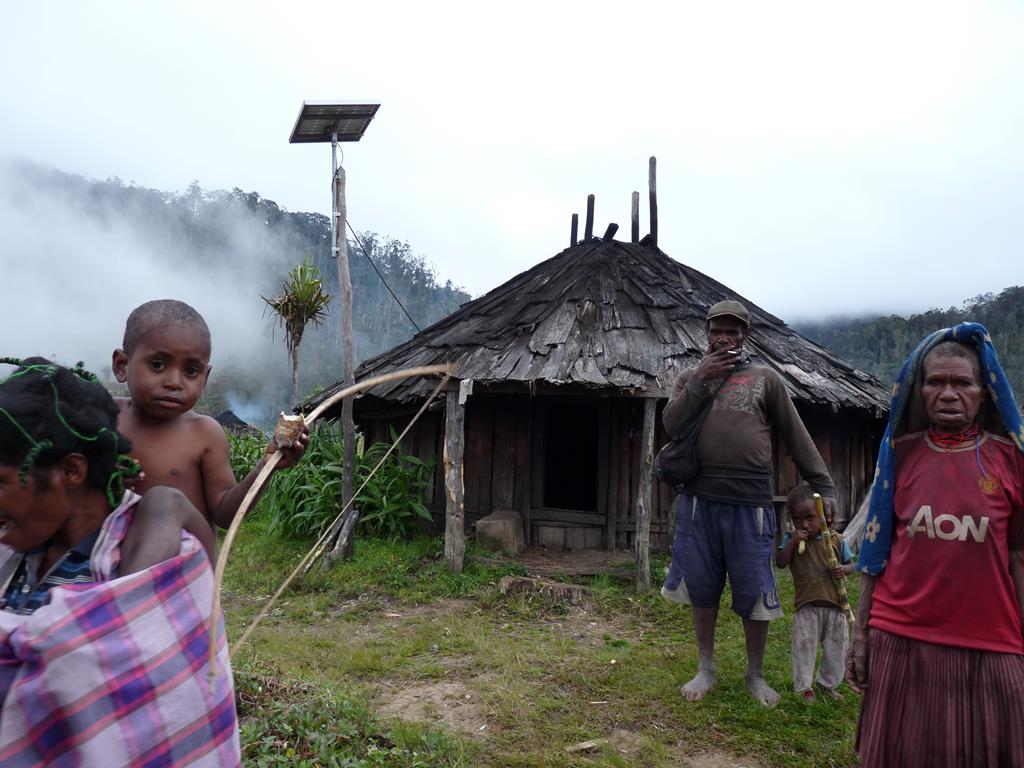 The honai (round hut for men) of the village chief in Kiroma had the distinctive solar panel perched on it. We first asked the village chief to be our guide for the next two days for the difficult pass ahead. “What do we need for the trip?, we asked. “Well, cigarettes…”, he started prioritizing. His Bahasa Indonesia skills were kind of worse than ours and we had initially imagined someone younger coming with us so we ended up going with someone else. It was not an easy choice though. For some reason there were very few, if any, young men in Kiroma.
The honai (round hut for men) of the village chief in Kiroma had the distinctive solar panel perched on it. We first asked the village chief to be our guide for the next two days for the difficult pass ahead. “What do we need for the trip?, we asked. “Well, cigarettes…”, he started prioritizing. His Bahasa Indonesia skills were kind of worse than ours and we had initially imagined someone younger coming with us so we ended up going with someone else. It was not an easy choice though. For some reason there were very few, if any, young men in Kiroma.The honai (round hut for men) of the village chief in Kiroma had the distinctive solar panel perched on it. We first asked the village chief to be our guide for the next two days for the difficult pass ahead.
 Forest is cleared to make space for gardens. The tree roots prevent landslides.
Forest is cleared to make space for gardens. The tree roots prevent landslides. Forest is cleared to make space for gardens. The tree roots prevent landslides.
 The way up from Kiroma follows a river valley surrounded by impenetrable jungle. The “path” was basically the river itself.
The way up from Kiroma follows a river valley surrounded by impenetrable jungle. The “path” was basically the river itself. The way up from Kiroma follows a river valley surrounded by impenetrable jungle. The
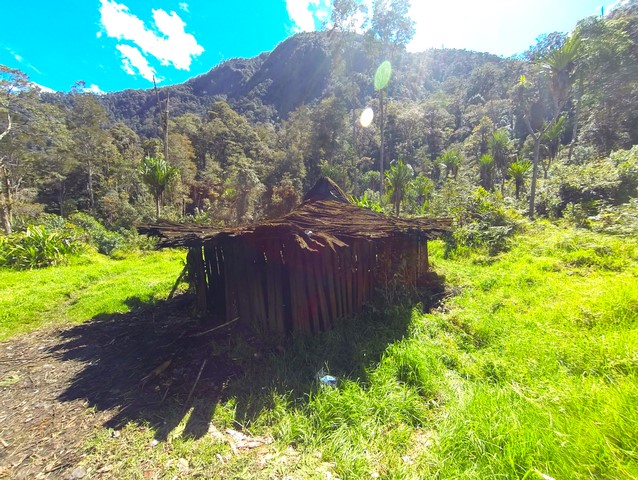 Julius wanted us to spend the night here, most probably trying to extend our trip by a day and get paid for a day more. The weather was nice and there was plenty of time so we pushed on to the hut on top of the pass where most people spend the night.
Julius wanted us to spend the night here, most probably trying to extend our trip by a day and get paid for a day more. The weather was nice and there was plenty of time so we pushed on to the hut on top of the pass where most people spend the night. Julius wanted us to spend the night here, most probably trying to extend our trip by a day and get paid for a day more. The weather was nice and there was plenty of time so we pushed on to the hut on top of the pass where most people spend the night.
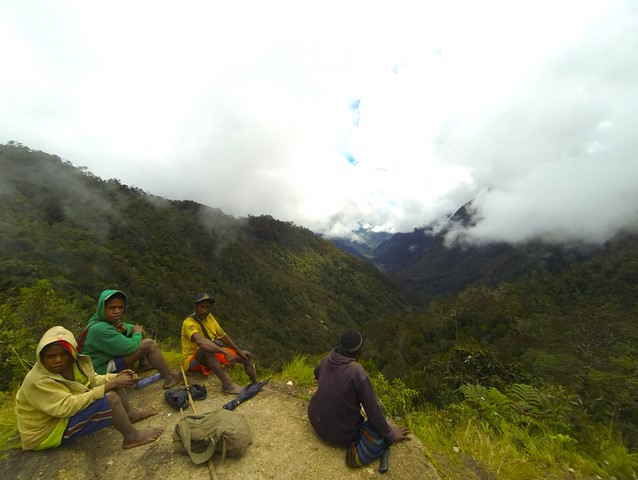 On the top of the pass the views were pretty amazing. From here on the path was slightly going up and down or flat, but in all cases featured loads of mud.
On the top of the pass the views were pretty amazing. From here on the path was slightly going up and down or flat, but in all cases featured loads of mud. On the top of the pass the views were pretty amazing. From here on the path was slightly going up and down or flat, but in all cases featured loads of mud.
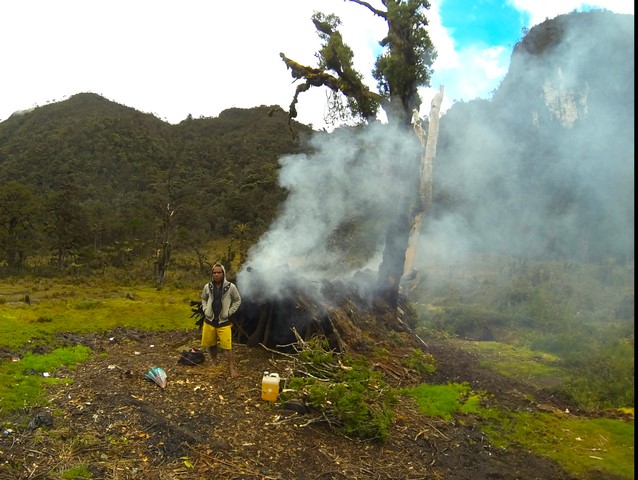 This is the hut at the top, locally known as Pelantara. The roof leaks (I know since it rained all night). That night there were around 15 people sleeping there and two fires were kept burning the whole night to prevent everyone from freezing (the altitude is 3500 m). The trick was to lie down all the time and stay as low as possible and allow the smoke above to escape from the sides of the hut. Fun times.
This is the hut at the top, locally known as Pelantara. The roof leaks (I know since it rained all night). That night there were around 15 people sleeping there and two fires were kept burning the whole night to prevent everyone from freezing (the altitude is 3500 m). The trick was to lie down all the time and stay as low as possible and allow the smoke above to escape from the sides of the hut. Fun times. This is the hut at the top, locally known as Pelantara. The roof leaks (I know since it rained all night). That night there were around 15 people sleeping there and two fires were kept burning the whole night to prevent everyone from freezing (the altitude is 3500 m). The trick was to lie down all the time and stay as low as possible and allow the smoke above to escape from the sides of the hut. Fun times.
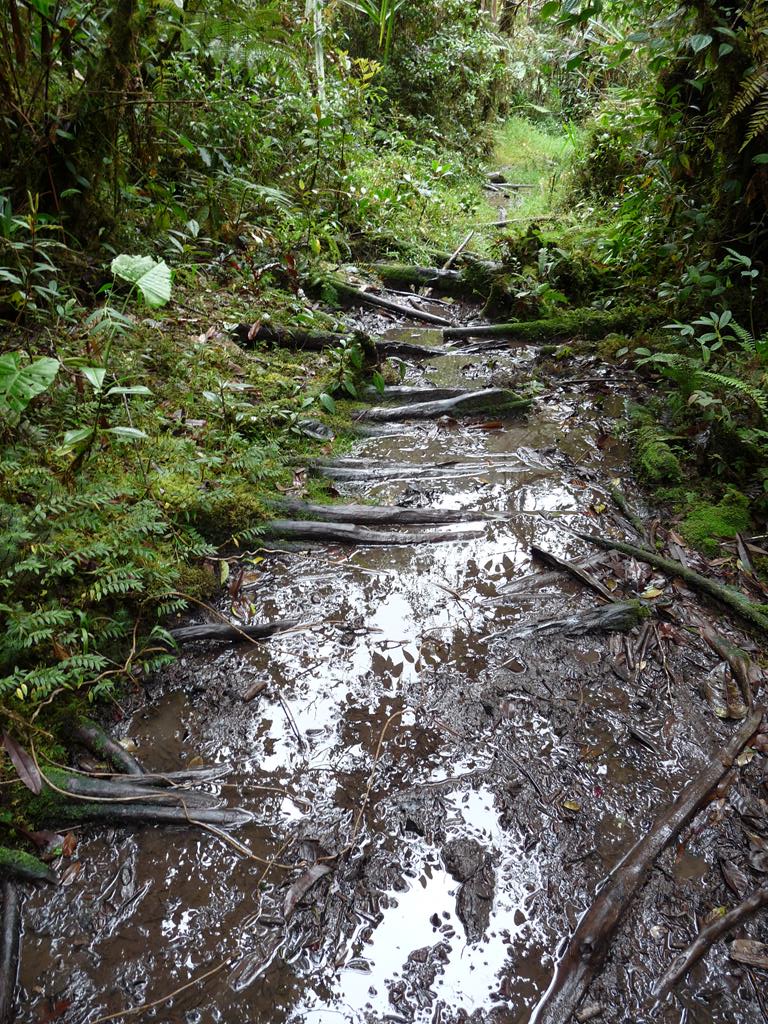 Did I mention the mud? It was everywhere. For three days we were walking in mud except when going down a vertical rock. Most times there would be some rocks or tree trunks trunks to step on. But it’s easy to lose balance or just mistake a chunk of mud for a rock. Then your feet go deep down, sometimes knee deep.
Did I mention the mud? It was everywhere. For three days we were walking in mud except when going down a vertical rock. Most times there would be some rocks or tree trunks trunks to step on. But it’s easy to lose balance or just mistake a chunk of mud for a rock. Then your feet go deep down, sometimes knee deep.Did I mention the mud? It was everywhere. For three days we were walking in mud except when going down a vertical rock. Most times there would be some rocks or tree trunks trunks to step on. But it's easy to lose balance or just mistake a chunk of mud for a rock. Then your feet go deep down, sometimes knee deep.
 The next morning we woke up early. Julius told us he had malaria (?!) and wanted to go back to Kiroma. We followed two brothers from Piliam, the next village down the path. When I say “down” I mean it! After a few hours on a very muddy and flooded plateau, the path goes down a vertical cliff. In the most difficult places ladders were put in place sometimes consisting of just a bunch of tree branches tied together with lianas.
The next morning we woke up early. Julius told us he had malaria (?!) and wanted to go back to Kiroma. We followed two brothers from Piliam, the next village down the path. When I say “down” I mean it! After a few hours on a very muddy and flooded plateau, the path goes down a vertical cliff. In the most difficult places ladders were put in place sometimes consisting of just a bunch of tree branches tied together with lianas. The next morning we woke up early. Julius told us he had malaria (?!) and wanted to go back to Kiroma. We followed two brothers from Piliam, the next village down the path. When I say
 Another one of those “ladders”. Going down here when it’s raining is out of the question.
Another one of those “ladders”. Going down here when it’s raining is out of the question. Another one of those
 We went down this cliff face, in the middle there. Looking back towards it, I think it was a bit crazy
We went down this cliff face, in the middle there. Looking back towards it, I think it was a bit crazyWe went down this cliff face, in the middle there. Looking back towards it, I think it was a bit crazy
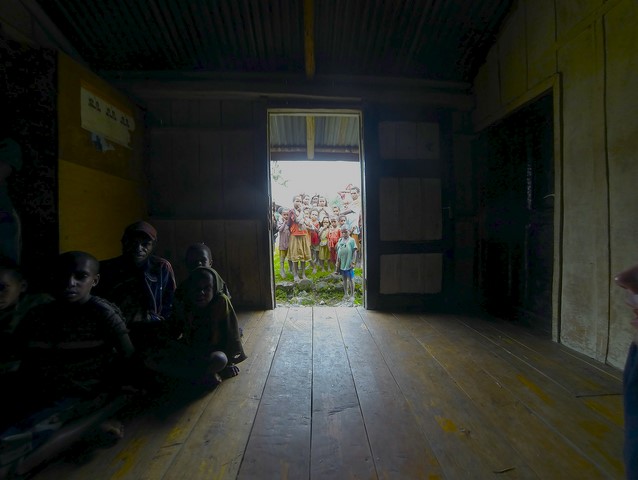 In Piliam we slept at the office of the village chief. As soon as we arrived and were shown into out quarters, a crowd of kids and adults gathered outside and watched us doing nothing basically. For hours. Someone said they had a TV in the village but that was probably broken or there was no electricity. Nicho said that he also heard someone coming to out window in the middle of the night. This is genuine, friendly curiosity.
In Piliam we slept at the office of the village chief. As soon as we arrived and were shown into out quarters, a crowd of kids and adults gathered outside and watched us doing nothing basically. For hours. Someone said they had a TV in the village but that was probably broken or there was no electricity. Nicho said that he also heard someone coming to out window in the middle of the night. This is genuine, friendly curiosity.In Piliam we slept at the office of the village chief. As soon as we arrived and were shown into out quarters, a crowd of kids and adults gathered outside and watched us doing nothing basically. For hours. Someone said they had a TV in the village but that was probably broken or there was no electricity. Nicho said that he also heard someone coming to out window in the middle of the night. This is genuine, friendly curiosity.
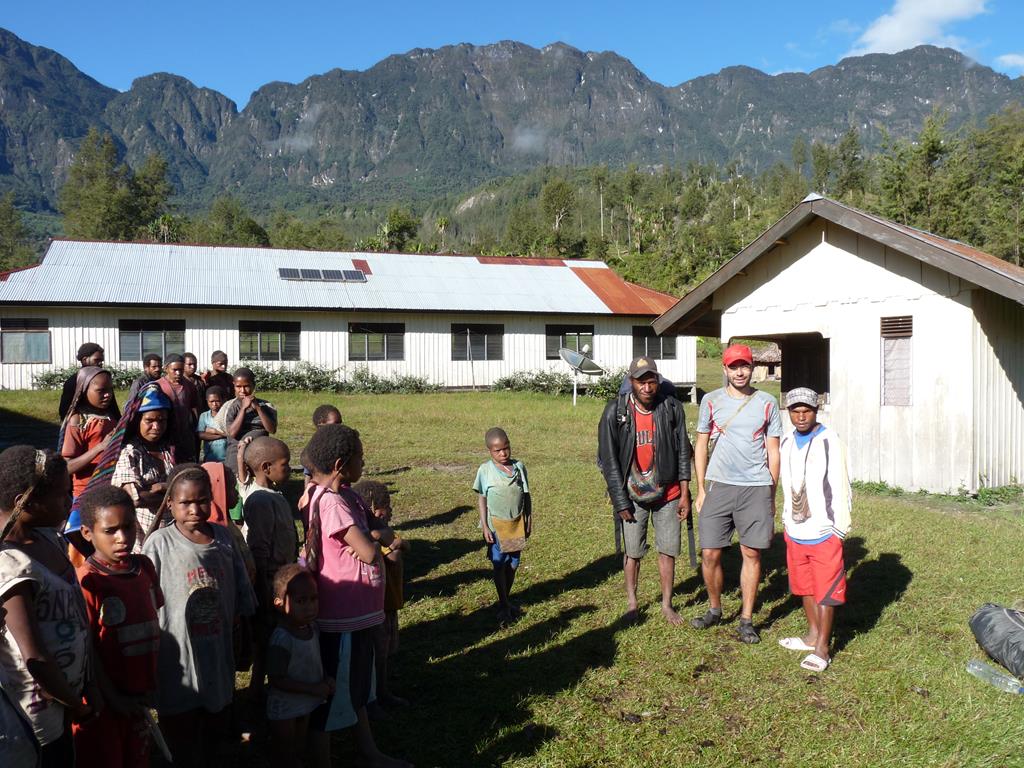 Goodbye picture at Piliam. Eki, one of the brothers who walked with us the day before tried on my backpack. He didn’t like it.
Goodbye picture at Piliam. Eki, one of the brothers who walked with us the day before tried on my backpack. He didn’t like it. Goodbye picture at Piliam. Eki, one of the brothers who walked with us the day before tried on my backpack. He didn't like it.
 These local…well… street musicians were happy to entertain us and for lack of anything better to do they followed us to the top of the pass for about two hours while also trying their slingshot skills on the birds in the forest. By now we were so tired and the blisters/sores on our feet so bad, that I couldn’t wrap my head around anyone wanting to walk up this mountain voluntarily. I wish I were a kid again.
These local…well… street musicians were happy to entertain us and for lack of anything better to do they followed us to the top of the pass for about two hours while also trying their slingshot skills on the birds in the forest. By now we were so tired and the blisters/sores on our feet so bad, that I couldn’t wrap my head around anyone wanting to walk up this mountain voluntarily. I wish I were a kid again.These local...well... street musicians were happy to entertain us and for lack of anything better to do they followed us to the top of the pass for about two hours while also trying their slingshot skills on the birds in the forest. By now we were so tired and the blisters/sores on our feet so bad, that I couldn't wrap my head around anyone wanting to walk up this mountain voluntarily. I wish I were a kid again.
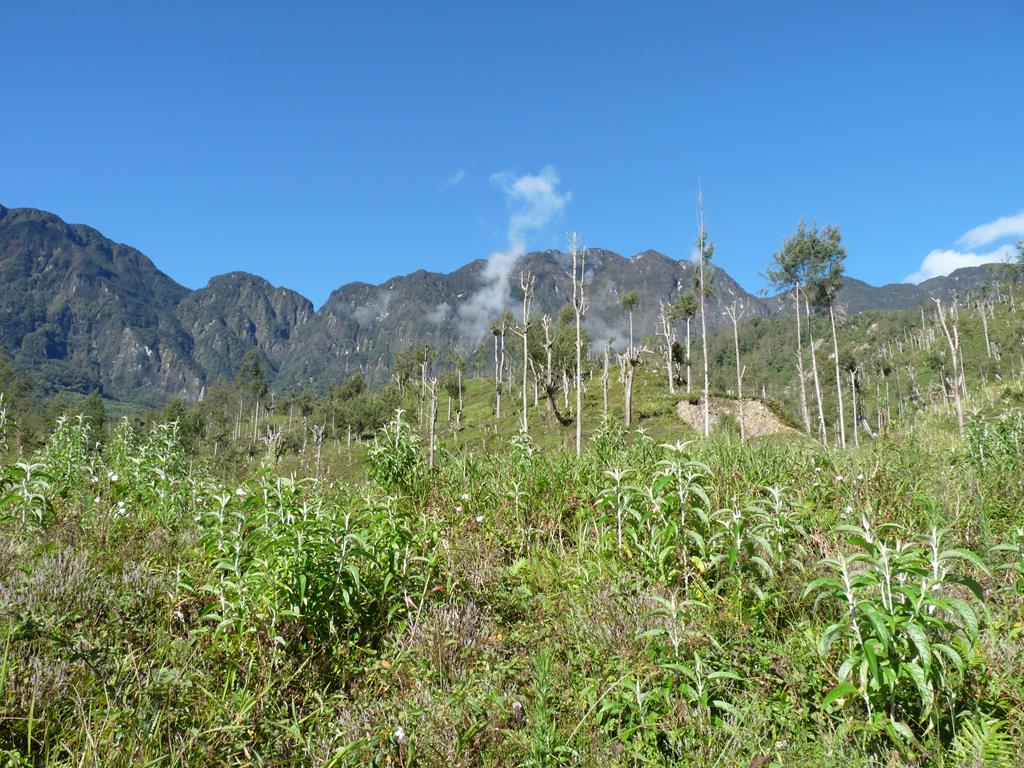 The second pass awaited us on the way from Piliam to Angguruk. This one was certainly lower and less challenging than the Mt Elite one but equally muddy. Someone said it took them 4 hours from Piliam to Angguruk so we took it easy. Well that someone must have been Superman cause it took us almost ten hours. There were many ups and downs that day.
The second pass awaited us on the way from Piliam to Angguruk. This one was certainly lower and less challenging than the Mt Elite one but equally muddy. Someone said it took them 4 hours from Piliam to Angguruk so we took it easy. Well that someone must have been Superman cause it took us almost ten hours. There were many ups and downs that day. The second pass awaited us on the way from Piliam to Angguruk. This one was certainly lower and less challenging than the Mt Elite one but equally muddy. Someone said it took them 4 hours from Piliam to Angguruk so we took it easy. Well that someone must have been Superman cause it took us almost ten hours. There were many ups and downs that day.
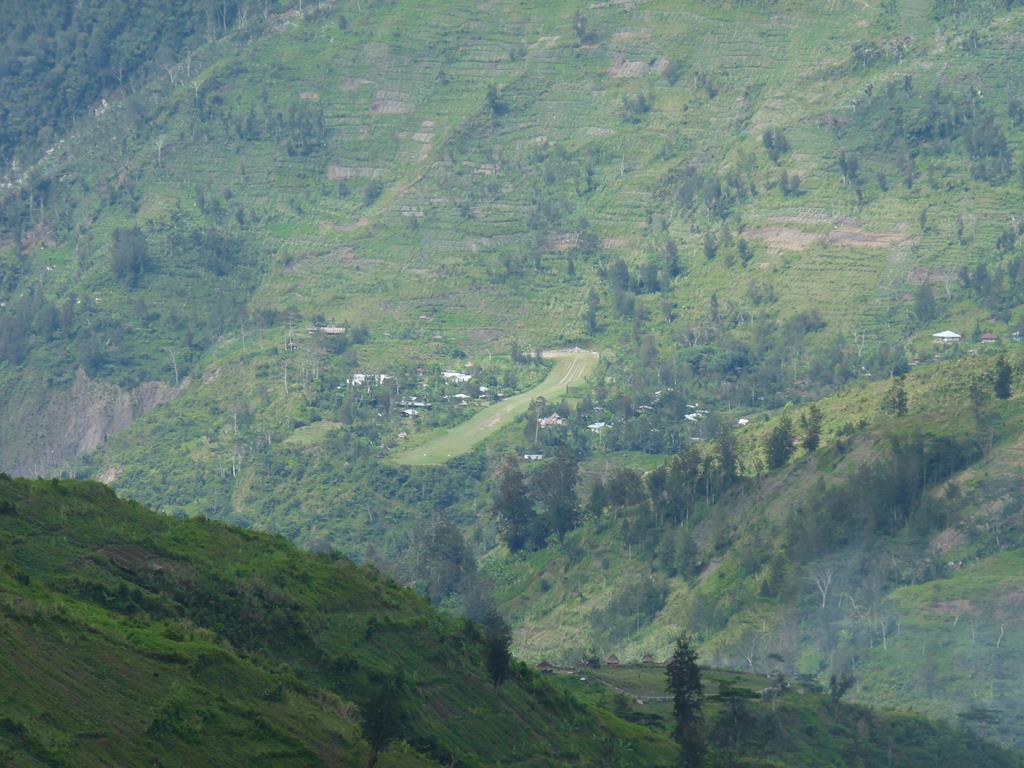 From the top of the pass we could clearly see Angguruk with its airstrip. So close yet so far away.
From the top of the pass we could clearly see Angguruk with its airstrip. So close yet so far away.From the top of the pass we could clearly see Angguruk with its airstrip. So close yet so far away.
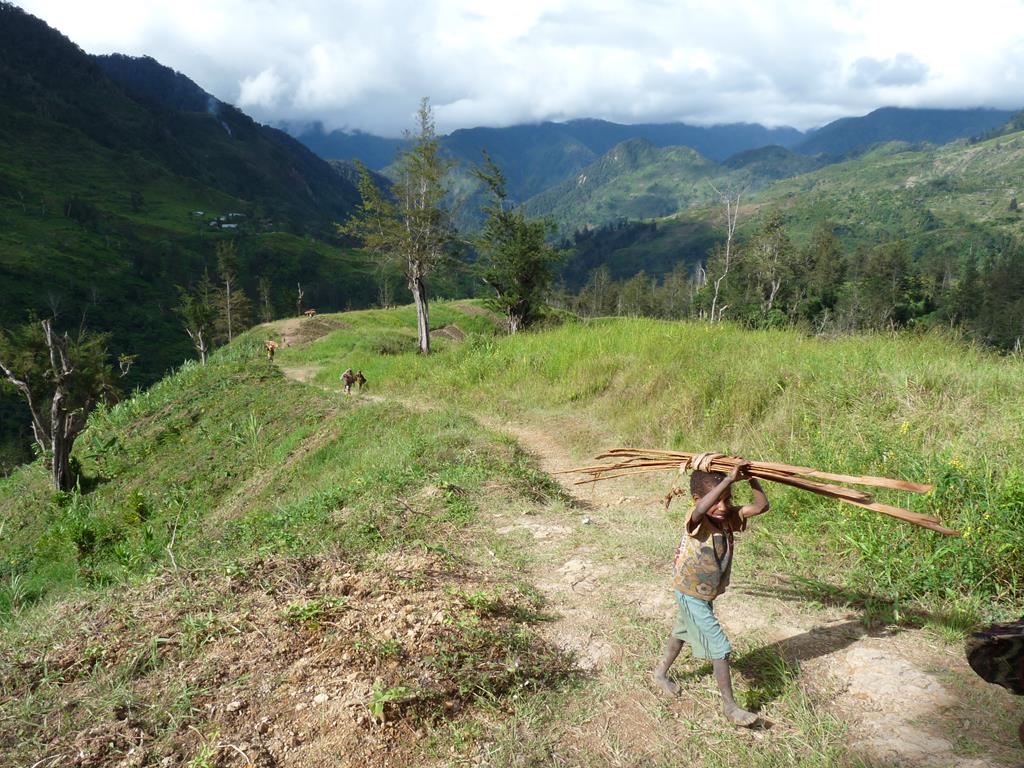 These planks had to be delivered higher up the hill where a new house was in construction for the needs of the village chief.
These planks had to be delivered higher up the hill where a new house was in construction for the needs of the village chief.These planks had to be delivered higher up the hill where a new house was in construction for the needs of the village chief.
 The last big river to cross. Luckily there was a bridge (a covered one) over the impressive canyon. From here it was mostly up up up (and some down + up up up) to Angguruk.
The last big river to cross. Luckily there was a bridge (a covered one) over the impressive canyon. From here it was mostly up up up (and some down + up up up) to Angguruk.The last big river to cross. Luckily there was a bridge (a covered one) over the impressive canyon. From here it was mostly up up up (and some down + up up up) to Angguruk.
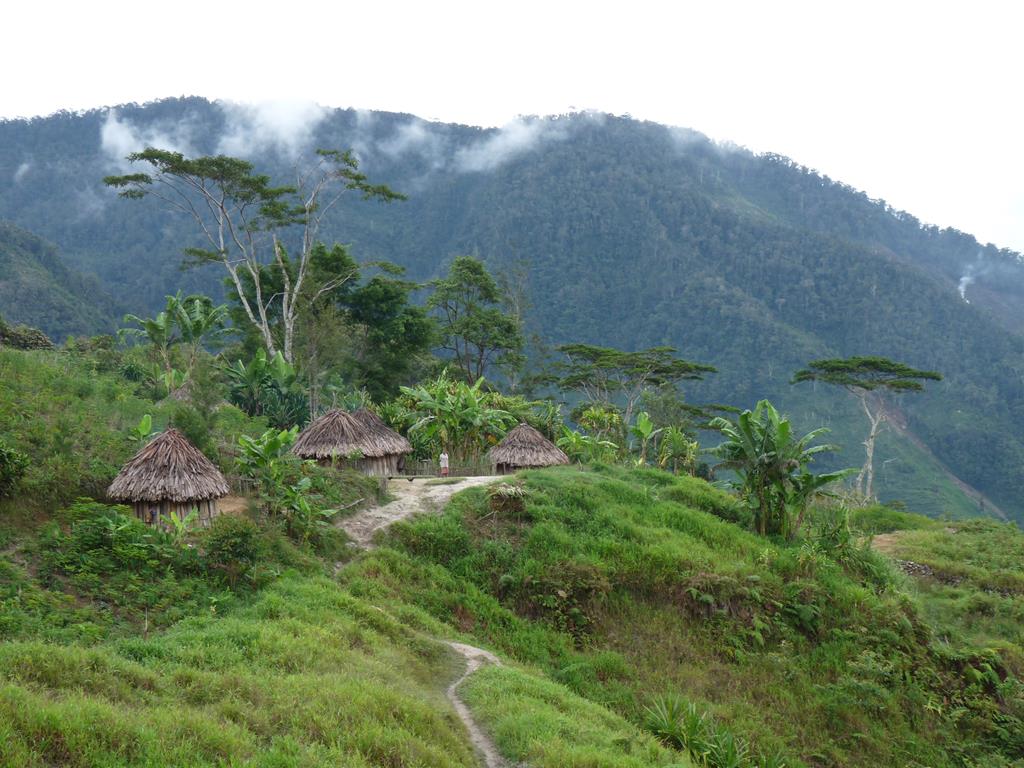 Approaching Angguruk we could see a difference. Villages were tidier, the path was better maintained. Still every step was painful.
Approaching Angguruk we could see a difference. Villages were tidier, the path was better maintained. Still every step was painful.Approaching Angguruk we could see a difference. Villages were tidier, the path was better maintained. Still every step was painful.
 Arriving in Angguruk was different than other villages. Instead of traditional honai we saw mostly modern buildings including this villa as I would call it. No idea who lives here. Angguruk was chosen as the base for missionaries working with the Yali people and therefore it has the best transportation and other facilities. And the only place where the solar batteries actually worked and it was possible to charge batteries.
Arriving in Angguruk was different than other villages. Instead of traditional honai we saw mostly modern buildings including this villa as I would call it. No idea who lives here. Angguruk was chosen as the base for missionaries working with the Yali people and therefore it has the best transportation and other facilities. And the only place where the solar batteries actually worked and it was possible to charge batteries.Arriving in Angguruk was different than other villages. Instead of traditional honai we saw mostly modern buildings including this villa as I would call it. No idea who lives here. Angguruk was chosen as the base for missionaries working with the Yali people and therefore it has the best transportation and other facilities. And the only place where the solar batteries actually worked and it was possible to charge batteries.
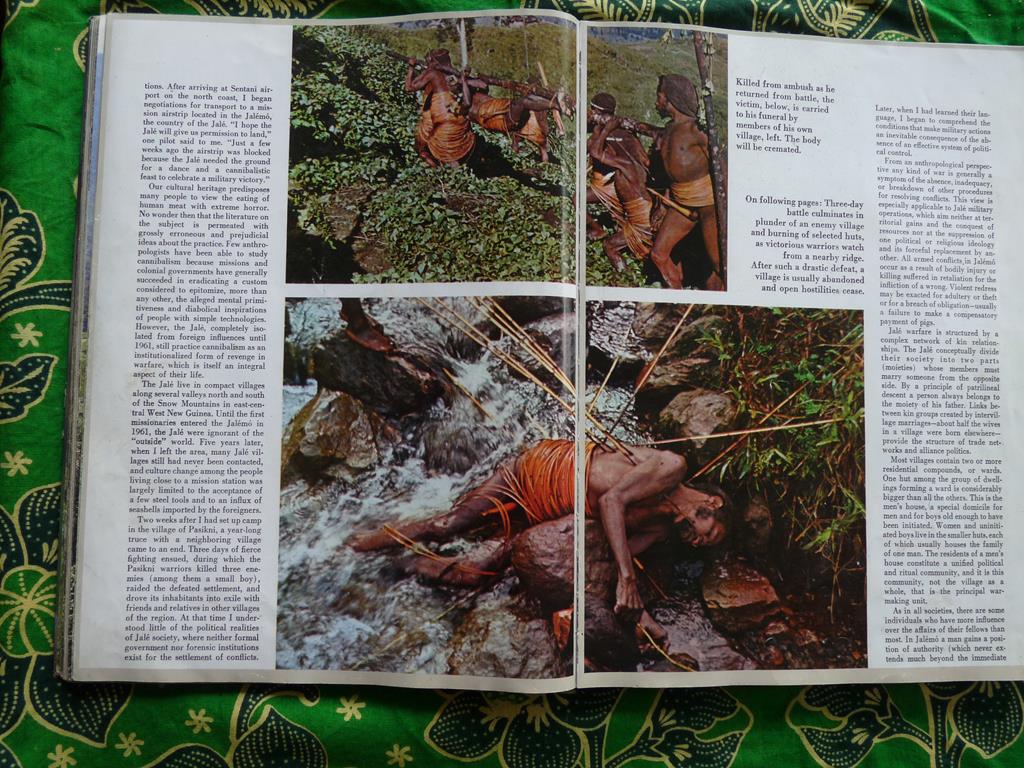 The Yali, as many other tribes practiced anthropophagy (cannibalism) until recently. As always it was related to a certain ritual – in their case, they would eat parts of the body of a killed enemy. Inter-village fights were “disputes over women, pigs and gardens, as it says in the article where these pictures were published. The first missionaries that came here in 1960 were killed and eaten. Since then the missionaries have made sure that as good Christians the locals would satisfy their protein needs by eating pigs only. Interestingly, we saw chickens only in Angguruk but in the other villages there were only pigs.
The Yali, as many other tribes practiced anthropophagy (cannibalism) until recently. As always it was related to a certain ritual – in their case, they would eat parts of the body of a killed enemy. Inter-village fights were “disputes over women, pigs and gardens, as it says in the article where these pictures were published. The first missionaries that came here in 1960 were killed and eaten. Since then the missionaries have made sure that as good Christians the locals would satisfy their protein needs by eating pigs only. Interestingly, we saw chickens only in Angguruk but in the other villages there were only pigs.The Yali, as many other tribes practiced anthropophagy (cannibalism) until recently. As always it was related to a certain ritual - in their case, they would eat parts of the body of a killed enemy. Inter-village fights were
 Angguruk had some pretty nice views of the surrounding valleys.
Angguruk had some pretty nice views of the surrounding valleys.Angguruk had some pretty nice views of the surrounding valleys.
 The grass airstrip at Angguruk ends with a 22 degree slope to make sure the planes come to a halt. For extra safety there’s a cross at the end of it.
The grass airstrip at Angguruk ends with a 22 degree slope to make sure the planes come to a halt. For extra safety there’s a cross at the end of it.The grass airstrip at Angguruk ends with a 22 degree slope to make sure the planes come to a halt. For extra safety there's a cross at the end of it.
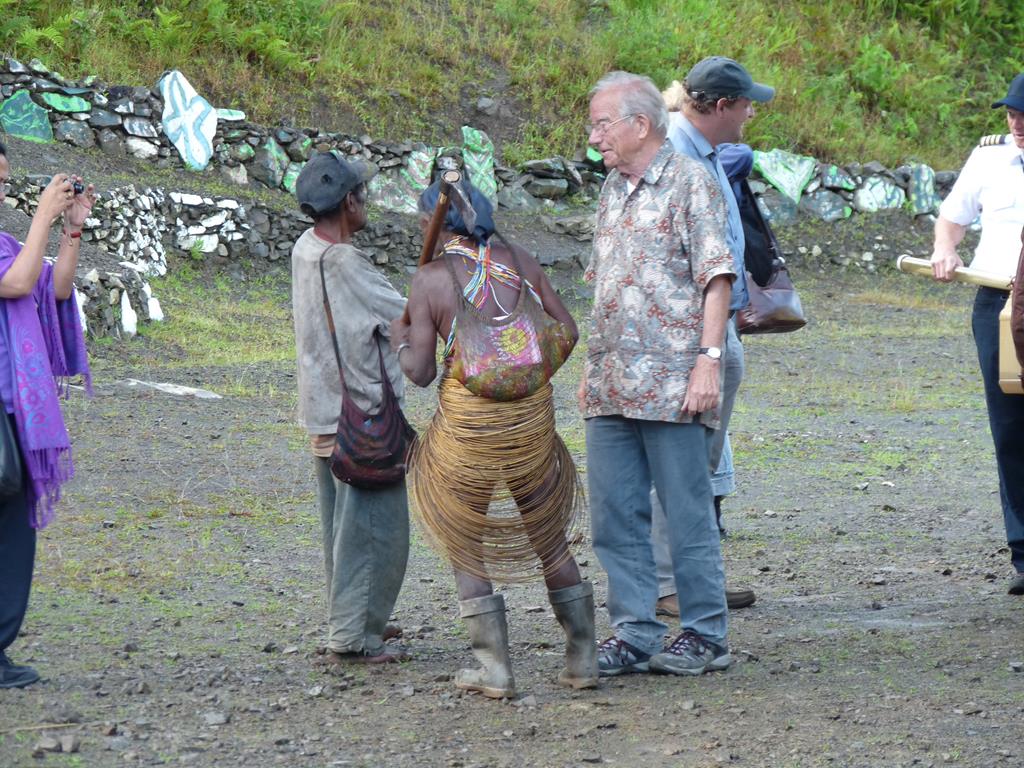 Mr. Zöllner is one of the early missionaries who converted the locals. Everyone was telling us about him arriving in a couple of days and here he is, fresh off the plane from Jayapura with his family. He comes to visit almost every year all the way from Germany. That was lucky since the plane that was apparently chartered for him, had some free seats for us on its way back to Jayapura.
Mr. Zöllner is one of the early missionaries who converted the locals. Everyone was telling us about him arriving in a couple of days and here he is, fresh off the plane from Jayapura with his family. He comes to visit almost every year all the way from Germany. That was lucky since the plane that was apparently chartered for him, had some free seats for us on its way back to Jayapura.Mr. Zöllner is one of the early missionaries who converted the locals. Everyone was telling us about him arriving in a couple of days and here he is, fresh off the plane from Jayapura with his family. He comes to visit almost every year all the way from Germany. That was lucky since the plane that was apparently chartered for him, had some free seats for us on its way back to Jayapura.
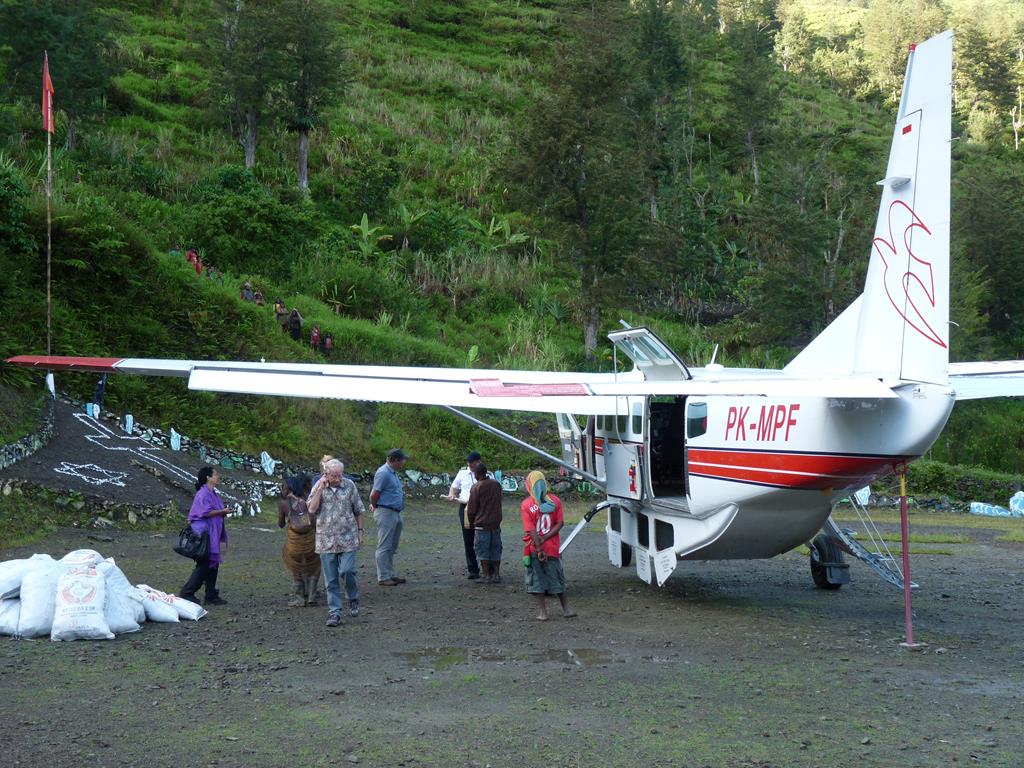
10) per person after the local MAF agent and the pilot performed some calculations. Before that we were also asked for a 100,000 to. departure tax. We didn’t get a receipt for that and the money disappeared too quickly for me to see if it departed for the drawer or the agent’s pocket. The flight was well worth it. I asked for a window seat and got to sit next to the pilot. “]
MAF (Missionary aviation fellowship) is a Protestant organization providing flights in remote areas of the world for the use of missionaries on Cessna planes like this that can land on grass air strips. We managed to get seats on this one going back to Jayapura. We wouldn't have minded going to Wamena instead and spending more time in the Baliem Valley but we couldn't be too picky. The day before there was a flight to Wamena but it was full. Locals (and their luggage and pigs) as well as missionaries a and NGOs have priority over tourists. We certainly didn't want to walk back to Wamena so that would be the end of the Highlands trip for now. The ticket from Angguruk to Jayapura set us back 1,320,000 rupiah (around $110) per person after the local MAF agent and the pilot performed some calculations. Before that we were also asked for a 100,000 to. departure tax. We didn't get a receipt for that and the money disappeared too quickly for me to see if it departed for the drawer or the agent's pocket. The flight was well worth it. I asked for a window seat and got to sit next to the pilot.
MAF (Missionary aviation fellowship) is a Protestant organization providing flights in remote areas of the world for the use of missionaries on Cessna planes like this that can land on grass air strips. We managed to get seats on this one going back to Jayapura. We wouldn’t have minded going to Wamena instead and spending more time in the Baliem Valley but we couldn’t be too picky. The day before there was a flight to Wamena but it was full. Locals (and their luggage and pigs) as well as missionaries a and NGOs have priority over tourists. We certainly didn’t want to walk back to Wamena so that would be the end of the Highlands trip for now. The ticket from Angguruk to Jayapura set us back 1,320,000 rupiah (around

10) per person after the local MAF agent and the pilot performed some calculations. Before that we were also asked for a 100,000 to. departure tax. We didn’t get a receipt for that and the money disappeared too quickly for me to see if it departed for the drawer or the agent’s pocket. The flight was well worth it. I asked for a window seat and got to sit next to the pilot.
MAF (Missionary aviation fellowship) is a Protestant organization providing flights in remote areas of the world for the use of missionaries on Cessna planes like this that can land on grass air strips. We managed to get seats on this one going back to Jayapura. We wouldn't have minded going to Wamena instead and spending more time in the Baliem Valley but we couldn't be too picky. The day before there was a flight to Wamena but it was full. Locals (and their luggage and pigs) as well as missionaries a and NGOs have priority over tourists. We certainly didn't want to walk back to Wamena so that would be the end of the Highlands trip for now. The ticket from Angguruk to Jayapura set us back 1,320,000 rupiah (around $110) per person after the local MAF agent and the pilot performed some calculations. Before that we were also asked for a 100,000 to. departure tax. We didn't get a receipt for that and the money disappeared too quickly for me to see if it departed for the drawer or the agent's pocket. The flight was well worth it. I asked for a window seat and got to sit next to the pilot.
The time has come for me to leave Indonesia. When I first arrived here I was going to stay three months. A few hours after I landed, I thought: “Let’s make it four”. Many years are not enough to see a country that is held together by little else than its diversity (and a pinch of military power). What it’s 17000+ islands have in common is their natural beauty and their smiling and easy-going inhabitants. I’m sometimes jealous of this easy-goingness that makes traveling much easier if you just let it be. In Angguruk, while waiting for an airplane to happen to appear and take us back to somewhere, I had time to finally finish the Swedish book called “The hundred year old man who crawled out of his window and disappeared” (highly recommended!) In there Indonesia is called “the land of possibilities”. And it is! It’s a place where you need to be prepared for anything and yet you can’t be prepared for anything.
I had big plans to visiting most of the major islands (Java, Sulawesi, Kalimantan, Maluku, Bali, Lombok, Flores, Papua, Timor…), but ended up not even reaching Java. However, apart from a short, quasilegal stop in Sumatra earlier this year, I only managed to explore some of Flores, Bali, Sumbawa and Papua on this trip. Slowly but with style and with many new friends. All in all, 12 islands, big and small. 16988+ to go. I’ll have to be back.
Next stop: Papua New Guinea
Practical information
Transportation – flights to Wamena from Jayapura cost 925,000 rp one way on Trigana air. Around the Baliem valley there are bemos that go to where there are roads. MAF, AMA and Susi air fly to air strips in the villages from Wamena, Sentani and sometimes between villages. Tourists have last priority. Church people, NGOs, locals, supplies and pigs are more important for sure. Angguruk seems to be one of the best served air strips with flights to somewhere almost every day.
Travel Permit – besides the Indonesian visa, for travelling in Papua one also needs a special travel permit – “surat jalan”. I got mine without any problems at the police station in Jayapura. Some people have apparently been asked for money but it should be free. I only showed a copy of my passport (my actual passport was at the PNG consulate) and I got a nice stamped piece of paper with my picture on it. I could travel with this to Wamena and beyond without having my passport on me. In fact noone really ever looked at our documents really well. We only registered our surat jalan in Wamena and in Kiroma. There are no police stations in the villages after that. We asked someone if there was police anywhere and we were told something like: “We don’t allow the police to come here”. When getting the surat jalan it is good to mention all areas in Papua that you plan to visit. Even to see the memorial on the hill above Sentani, you need the surat jalan. Only in Jayapura itself it is not necessary.
Accommodation – we couchsurfed in Jayapura. The local CS community is very friendly. Jayapura and Wamena accommodation is generally more expensive than in the rest of Indonesia. In the villages on the trek, we paid 100,000 per person to sleep in a house. At the church in Kurima we donated 50,000 to the church.
Food – at the villages there are sweet potatoes in abundance, you can buy rice for as much as 50,000 per kilo and instant noodles for 5000 per piece. If are lucky there will be something green as well. We usually asked the locals to cook for us. It is good to bring some protein with you – tuna cans for example, all the way from Jayapura. Wamena is very expensive. We drank water mostly from the streams, purified with iodine. In the villages they boil it. For the two-day passage without any villages we brought a lot of sweet potatoes and rice and cooked at the top. Our guide carried this for us.
Routes; guides and porters – more or less unncessary (if you speak some Indonesian)! We hired someone to carry the food for us and show us the way over the pass through Mt Elite. We probably would have gotten lost if we had been alone, but there are many locals walking this route, so it was never long before we met someone. For the routes around the Baliem Valley a guide is absolutely unnecessary. If you get the map from Papua.com, it is absolutely enough. From Kurima it is possible to walk for a couple of days on the way to Kiroma and then, in the village before, after the bridge, go back on the opposite side of the valley through some other villages. The views are super nice, even if you don’t go across the mountain to Yalimo. Most tourists actually do exactly that route in five days, strangely having guides and god knows how many porters tagging along and also paying hundreds of dollars a day. We met two Dutch guys doing that route – the only tourists we met. For going to Angguruk, there’s apparently another route described by this guy. I tried asking a few locals about that route but most seemed not to consider it an option at all for some reason. Only one person confirmed it existed but said it was a bad path. Although it’s difficult to know for sure. The path over Mt Elite was not good either. I’m sure it’s used often enough by the villages in that area.
Equipment – I brought too much stuff. My lightweight tent I never used. The sleeping bag was useful. I had too many shirts. Basically with a sleeping bag and a warm and waterproof jacket and a change of clothes you will be fine. I used my old sandals that I bought in India for $5 most of the way and that was very good – there is a lot of mud and rivers to cross. Someone mentioned rubber boots – I am not sure how comfortable these would be for such a tough trek. Most locals walk barefoot, but their feet are well trained. So basically sandals is the shoe of choice.
Presents – it is good to bring presents to the locals. Many people mention cigarettes and indeed many locals seem to smoke. Rolling tobacco is cheaper and a better present than a pack of cigarettes that will disappear very quickly. If you smoke, some people will be all over you. A lady told me once very proudly: “My sons (aged 9 and 10) already smoke!”, which was supposed to mean “Give them some cigarettes please!”. Coffee, but not the instant one that is just sugar and milk – they will give it to the kids instead. Sugar might be good. I gave some notebooks and pens to children.
Language – most people speak Indonesian. Without some Indonesian skills, you might have to go to the hundreds-of-dollars-a-day English speaking guides in Wamena. Still, even if Nicho spoke much better Indonesian than me, misunderstandings were common and answers to questions like “How long does it take to walk between village A and village B?” easily vary between “I don’t know how to think in hours” to “two hours” to “two days”. After some language skills, the most useful skills are patience and a smile.
Photos – many people warn you that you will be asked to pay for photographing people. That might be the case around Wamena, especially at that circus village with the mummy. In the villages on the trail noone asked for money for photography. However I always asked for permission of course. The only exception was one guy who was carrying a big gun in the middle of the forest. I asked if I could take a picture
“What will you give me?”, he asked.
“I can give you cigarrettes!”
“What kind of cigarettes?”
“Rolling tobacco”
“I don’t want it”, he said and left.
Safety – I never felt threatened. Everyone was smiling and super nice. There is no Indonesian military or police in the villages. However, Papua is a place of conflict between the Free Papua Movement and the Indonesian government. None of them seem to target tourists or regular citizens anymore. However, in the past, the Indonesian government carried out a de facto genocide in Papua. Many things in Papua are related to one name: Freeport. It’s a mining company that operates the world’s largest gold mine in the south of Papua. That’s a lot of money flowing towards Jakarta and quite a bit of pollution. I had a chance to see it with my eyes when my flight from Bali to Jayapura made a sunrise stopover in Timika, close to the mine. There’s a lake next to Timika where all the chemical waste from the mine collects. It’s a sad view. Part of the reason why the Norwegian Petrol Fund sold its stake in Rio Tonto (Freeport’s parent company). More on Freeport.
Back to the point – the trail conditions and weather might be the biggest concern when it comes to safety.
Mosquitoes /malaria – you hear so many stories. Papua is considered to have high levels of malaria. Jayapura and the coastal regions certainly do. In some places you ask if there is malaria and they will say “noooo”, although there actually is. In other places the word “malaria” has become synonymous with “being sick” so people might say they have malaria as soon as they cough twice. I had mosquito repellent and used it in the evenings, except when we were quite high above sea level. I don’t take malaria prevention pills but have doxycycline with me just in case.
Fleas. Well, there are some. Both me and Nicholas got bites three nights in a row. Or maybe they were bed bugs? But since we hardly ever slept on anything even reminding of a bed, I’m holding on to the flea theory.
Money – sit down before you google “trekking in the Baliem valley”. The prices you will see are whopping. Some even promise to take you to people who have never seen a white man before. This is crazy – missionaries, governments and mining companies went there before you, for sure! We did it the cheap way. We carried our bags and had a guide only for two days. I bought few souvenirs. A noken – á bag made of string made from wood fiber that is the bag of choice in the Highlands. I just needed something for when I’m out in cities. I also managed to find a koteka. It took a while to find my size but finally I got lucky. Later I found a dead cockroach inside so I haven’t tried it on yet. This is a breakdown of the prices per person in rupiah:
925,000 one way flight Jayapura to Wamena
1,420,000 one way Angguruk to Jayapura
800,000 for sleeping in villages
200,000 for guides (our guides charged 200,000 per day for two days)
around 500,000 for food and other expenses
All in all around $340 for a total of 9 days with the flights being around 2/3 of that.
